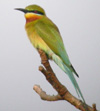INTRODUCTION
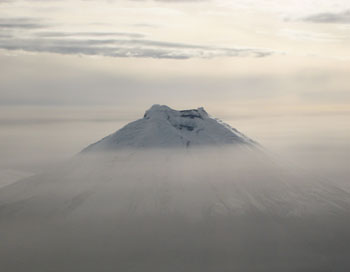 A trip to Ecuador or Costa Rica had been on the horizon for several years and in the end we decided to take the plunge after numerous discussions with tour operators at the Bird Fair over the last two years. The die was cast and Ecuador came out on top. We ended up speaking and planning at length with two companies; Tropical Birding and Neblina Forest. Initially both were very helpful with planning itineraries and deciding where to visit, costing, guides, etc but after a while, as we were about to decide who to trust our arrangements to, Iain Campbell at Tropical Birding took the huff as we had the gall to still be talking to someone else and abruptly told us he wasn’t prepared to reserve a particular guide for us and advised we would be better making other arrangements. I was so taken aback by his attitude I couldn’t think of a suitable decent reply to his terse email. In some respects this saved us a difficult decision as Byron Palacios, Neblina Forest’s representative in the UK at the time, had impressed us with his attitude and help to date. Neblina therefore ended up handling all our ground arrangements in Ecuador, including internal flights. A trip to Ecuador or Costa Rica had been on the horizon for several years and in the end we decided to take the plunge after numerous discussions with tour operators at the Bird Fair over the last two years. The die was cast and Ecuador came out on top. We ended up speaking and planning at length with two companies; Tropical Birding and Neblina Forest. Initially both were very helpful with planning itineraries and deciding where to visit, costing, guides, etc but after a while, as we were about to decide who to trust our arrangements to, Iain Campbell at Tropical Birding took the huff as we had the gall to still be talking to someone else and abruptly told us he wasn’t prepared to reserve a particular guide for us and advised we would be better making other arrangements. I was so taken aback by his attitude I couldn’t think of a suitable decent reply to his terse email. In some respects this saved us a difficult decision as Byron Palacios, Neblina Forest’s representative in the UK at the time, had impressed us with his attitude and help to date. Neblina therefore ended up handling all our ground arrangements in Ecuador, including internal flights.
Biologically, South America is the richest continent on Earth. The Amazon Basin holds the largest and most diverse tract of tropical rainforest on the planet and the Andes harbours an astonishing variety of ecosystems ranging from the tundra-like páramo and epiphyte-laden cloud forest to rain-shadow valleys and deciduous deserts. The diversity of birdlife found in Ecuador is the greatest, in relation to size, in South America and with friendly people, relatively short travel distances and good accommodation, birdwatching here is incredible.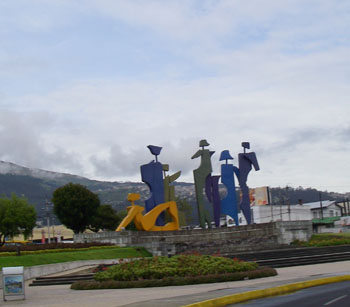
INDEX
Flights
Accommodation
Food
Transport
Guides
Costs
Research and Trip Essentials
Weather
Itinerary
Diary and Sites Visited
Summary
Trip List
Bird Photos
FLIGHTS
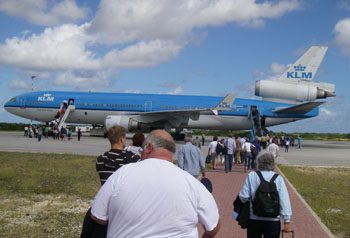 We arranged our flights to Ecuador early in October 2007 via Hays Travel (formerly St Andrews Travel) who had always served us well in the past. We used KLM flying from Manchester via Amsterdam. Wanting creature comforts we flew Business Class departing Manchester at 19.20 on 4th January and arriving Amsterdam 21.40. Flight KL753 left Amsterdam at 23.25 arriving in Quito at 09.00 the following morning. We returned on Flight KL 754 departing Quito at 10.15 on 27th January arriving Amsterdam 05.00 the next morning, with a connecting flight to Manchester leaving at 07.20 and arriving at 07.45 (local times are used). The Amsterdam-Quito flight uses the same aircraft throughout, but stops at Bonaire (Netherlands Antilles) and Guayaquil before arrival at Quito and onward return via Bonaire to Amsterdam. Stops are at least 1 hour in each location for fuel, cleaning, debarkation and embarkation. We arranged our flights to Ecuador early in October 2007 via Hays Travel (formerly St Andrews Travel) who had always served us well in the past. We used KLM flying from Manchester via Amsterdam. Wanting creature comforts we flew Business Class departing Manchester at 19.20 on 4th January and arriving Amsterdam 21.40. Flight KL753 left Amsterdam at 23.25 arriving in Quito at 09.00 the following morning. We returned on Flight KL 754 departing Quito at 10.15 on 27th January arriving Amsterdam 05.00 the next morning, with a connecting flight to Manchester leaving at 07.20 and arriving at 07.45 (local times are used). The Amsterdam-Quito flight uses the same aircraft throughout, but stops at Bonaire (Netherlands Antilles) and Guayaquil before arrival at Quito and onward return via Bonaire to Amsterdam. Stops are at least 1 hour in each location for fuel, cleaning, debarkation and embarkation.
Flight Times:-
Manchester-Amsterdam 1 hour
Amsterdam-Bonaire 10 hours
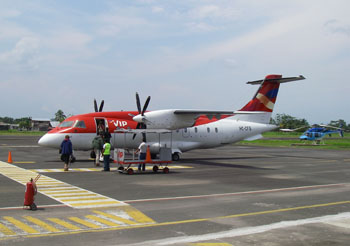 Bonaire-Guayaquil 2 hours 50 minutes Bonaire-Guayaquil 2 hours 50 minutes
Guayaquil-Quito 30 minutes
Quito-Bonaire 2 hours 10 minutes
Bonaire-Amsterdam 8 hours 30 minutes
Quito-Loja with Tame 50 minutes
Quito-Coca with VIP 30 minutes
Manchester-Quito Schedules comparison:-
KLM Out 18hrs 40 mins Return 16hrs 30 mins
Iberia Out 26hrs 40 mins Return 20hrs 25 mins
Back to Index
ACCOMMODATION
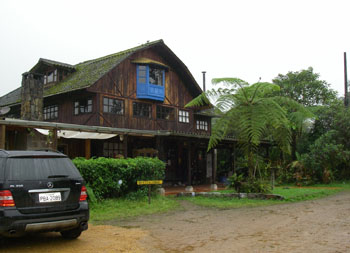 Travelling extensively, our path crossed Quito several times. Whilst here we used Hotel Sebastian staying a total of 6 nights. The rooms are large, with either double or twin beds. Everywhere is clean and very comfortable, the food is good and English is spoken by several of the staff, who are all very helpful. We stayed on the 5th and 7th Floors and had no problems with noise from the street below. The Hotel is 5 km from the airport and proved to be very convenient for all our requirements, including two computers, with free internet access, which are available for guests. Travelling extensively, our path crossed Quito several times. Whilst here we used Hotel Sebastian staying a total of 6 nights. The rooms are large, with either double or twin beds. Everywhere is clean and very comfortable, the food is good and English is spoken by several of the staff, who are all very helpful. We stayed on the 5th and 7th Floors and had no problems with noise from the street below. The Hotel is 5 km from the airport and proved to be very convenient for all our requirements, including two computers, with free internet access, which are available for guests.
On our travels (where all rooms were en suite) we visited:-
Sachatamia Lodge Mindo
We had the top floor suite with both a double and single bed and a large adjacent sitting area. This was very comfortable, but probably not representative of all the other rooms. Everywhere was clean, the staff were attentive, although no English was spoken and the food was very good.
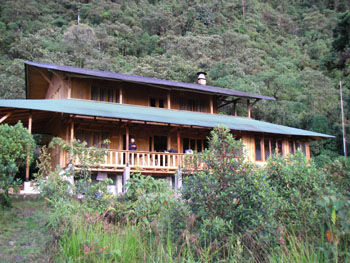 Tapichalaca Lodge Tapichalaca Lodge
Our room was a little on the small size here, but still had a double bed and was very comfortable and clean. Although no English was spoken, the local staff were excellent, being very friendly and providing good food. They were also prepared to provide a very reasonably priced laundry service.
Hotel Libertador Loja
Our room was large, comfortable and clean, but a little tired. The food in the restaurant was OK but very little English was spoken (the menu was only in Spanish) and we were glad William was with us to act as interpreter. The pillows on the bed were hard (very) and with our room facing the street, there was quite a bit of noise from the road as we tried to get to sleep at 21.30. Free internet access was available to guests via one computer.
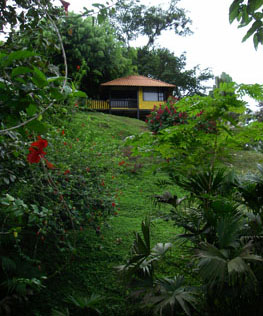 Tundaloma Lodge Tundaloma Lodge
The lodge is in an excellent location and has been under new management for about 6 months (Jan 2008). There were few other guests when we were there and we were allocated cabin No 1, halfway up the steep climb to the dining room and bar on the hilltop where the property is situated. Andreas, the manager, speaks a little English. The detached cabin was quite small with a double bed and two bunk beds. Air was circulated by a wall mounted fan over the bed but there were frequent lengthy power cuts every day whilst we were there. The windows in the bath room/toilet were large and clear glass and although there was a shower curtain which covered the bath and full window on one side, the other window was only half covered and, looking out over the grounds and car park, it was possible to watch birds (and be watched) whilst on the loo. Every time we had a shower, the water ran cold in under a minute. The whole place was in need of a little TLC and although some headway was being made, simple home comforts were missing when we arrived (only one set of towels, no drinking water, no spare loo roll, no non-slip bath mat in shower). The owners are trying, but there is quite a bit of room for improvement. Internet access was offered, if required.
Termas de Papallacta Lodge and Spa
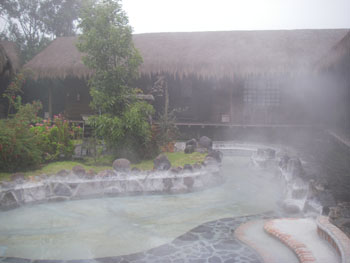 We were in cabin No 10 around the main thermal pools. The room was spotless, very comfortable with a single, as well as double bed and was heated by a hot air fan assisted by the thermal springs. There was a spacious dining area and the food was OK. Unfortunately there was a group of North American teenagers on a school trip who appeared to have little or no supervision and around 21.00 as we were turning in for the night, they decided to have a party in and around the pool outside our cabin window until 24.00. Unfortunately there was also a table and two chairs, provided for smokers, on the walkway outside the room, right next to our window and a couple from one of the adjoining rooms chose to drink, smoke and talk loudly there for a few hours…perhaps they were supervising the party! Needless to say, being up early the next morning, we had very little sleep. We were in cabin No 10 around the main thermal pools. The room was spotless, very comfortable with a single, as well as double bed and was heated by a hot air fan assisted by the thermal springs. There was a spacious dining area and the food was OK. Unfortunately there was a group of North American teenagers on a school trip who appeared to have little or no supervision and around 21.00 as we were turning in for the night, they decided to have a party in and around the pool outside our cabin window until 24.00. Unfortunately there was also a table and two chairs, provided for smokers, on the walkway outside the room, right next to our window and a couple from one of the adjoining rooms chose to drink, smoke and talk loudly there for a few hours…perhaps they were supervising the party! Needless to say, being up early the next morning, we had very little sleep.
Guango Lodge
We had an excellent lunch at this small, friendly birding lodge which is under the same ownership as San Isidro. With hindsight, although Termas was very comfortable, we would probably have been better staying overnight here, only 20 minutes down the road and in much more peaceful surroundings.
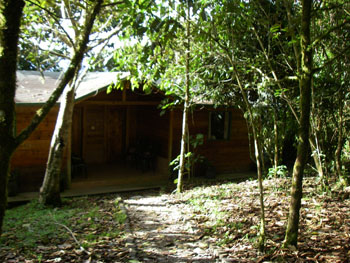 Cabanas San Isidro Cabanas San Isidro
We were allocated No2, a very comfortable semi-detached cabin nearest to the car park. The room had twin beds, was spotless and had its own seating area with table and chairs, plus a small outside balcony overlooking the forest. The food was excellent and perhaps too imaginative for some tastes. With a North American manageress, language was not an issue. Overall, this was probably the best and most enjoyable accommodation we stayed in.
Napo Wildlife Centre
Described as a luxury lodge situated within the Yasuni National Park, a UNESCO Biosphere Reserve. The area is said to have the largest, best conserved and most diverse tract of Amazon Rain Forest in Ecuador. Built on the shore of Añangu Lake, NWC is a conservation project which supports a unique 82 square-mile (22,000 hectare) private nature reserve within the park, and is an ancestral territory of the Añangu community who own the centre. Anyway, enough of the publicity material. We were allocated No7 a lakeside cabin providing rustic rather than luxury accommodation (suppose all things are relative in the jungle). We had a large room with a comfortable double bed and a second, part partitioned section with a further single bed.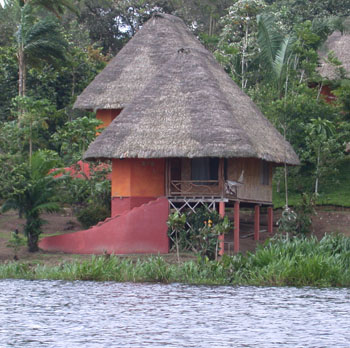 A ceiling fan kept the air moving. The bathroom was clean, although the brown water, which came from the lake and was recycled back there in an ecologically sound manner, could be a little disconcerting at times. The furniture was however quite dusty, especially the chairs. Each veranda had a hammock slung across it – a nice idea, but a table and chairs would have been a distinct improvement. Access to our cabin was up a slippery painted concrete slope plus 9 slippery painted concrete steps – again, a nice idea but not very practical (speaking from experience). Staff were attentive and the meals were quite varied in content and were OK to good overall (as long as you didn’t mind ants in the sugar and occasionally on your plate). The drinking water was always tepid and would have benefitted from refrigeration. The place has a commercial and touristy feel to it and appears to be run to a set formula (anyone remember “Fantasy Island”?). Transport throughout is by dugout canoe; although we never found ourselves up a creek without a paddle. The excursions into the jungle all potentially involve an early breakfast with a daily 04.30 wake up call, both for birders and non-birders alike. Overall NWC was probably one of the least enjoyable experiences of our trip. Internet access was offered at US$5 for 30 minutes. A ceiling fan kept the air moving. The bathroom was clean, although the brown water, which came from the lake and was recycled back there in an ecologically sound manner, could be a little disconcerting at times. The furniture was however quite dusty, especially the chairs. Each veranda had a hammock slung across it – a nice idea, but a table and chairs would have been a distinct improvement. Access to our cabin was up a slippery painted concrete slope plus 9 slippery painted concrete steps – again, a nice idea but not very practical (speaking from experience). Staff were attentive and the meals were quite varied in content and were OK to good overall (as long as you didn’t mind ants in the sugar and occasionally on your plate). The drinking water was always tepid and would have benefitted from refrigeration. The place has a commercial and touristy feel to it and appears to be run to a set formula (anyone remember “Fantasy Island”?). Transport throughout is by dugout canoe; although we never found ourselves up a creek without a paddle. The excursions into the jungle all potentially involve an early breakfast with a daily 04.30 wake up call, both for birders and non-birders alike. Overall NWC was probably one of the least enjoyable experiences of our trip. Internet access was offered at US$5 for 30 minutes.
Back to Index
FOOD
As we travelled Business Class the in-flight food was good. The only drawback is being woken up at 03.00/04.00 in the morning for breakfast; that is, if you have managed to get to sleep. At least you do have the choice of whether or not you want breakfast. The food in Ecuador varied mainly from good to excellent with the best being San Isidro and Guango Lodges. Food was always plentiful with lots of fresh fruit and fruit juice. One area which could have been improved was the picnic or box lunches provided by Neblina out of Quito. Neither quality nor quantity were a problem, it was the boring repetitive nature of the food. We had 3 or 4 cold chicken leg joints and 2 cold pork steaks as alternatives once the abundance of chicken had been pointed out. This was always accompanied by a pasta salad, which invariably looked and tasted the same. Bags of plantain crisps and a sweet flavoured popcorn always accompanied the meal and were repeatedly returned unopened. A bit more variety would have been appreciated. The picnic lunches provided by both Sachatamia and San Isidro were excellent and surprisingly, as it had accompanied us on the plane from Quito, the lunch on the boat ride down the Napo River was good, with a sandwich rather than cold meat and pasta.
Back to Index
TRANSPORT
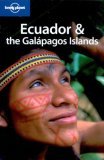  Four wheel drive vehicles and drivers were provided by Neblina Forest. Local flights from Quito to both Loja and Coca and back saved considerable time on the road. Transport at Napo was by dugout canoe. A large proportion of the roads on which we travelled were unmetalled tracks and with heavy rainfall they can at times be very muddy or even disintegrate altogether. The majority can probably be negotiated in an ordinary car but we were very grateful on a number of occasions to be in a 4x4 and this also allowed us to visit some areas which we wouldn't otherwise have attempted. Four wheel drive vehicles and drivers were provided by Neblina Forest. Local flights from Quito to both Loja and Coca and back saved considerable time on the road. Transport at Napo was by dugout canoe. A large proportion of the roads on which we travelled were unmetalled tracks and with heavy rainfall they can at times be very muddy or even disintegrate altogether. The majority can probably be negotiated in an ordinary car but we were very grateful on a number of occasions to be in a 4x4 and this also allowed us to visit some areas which we wouldn't otherwise have attempted.
Back to Index
GUIDES
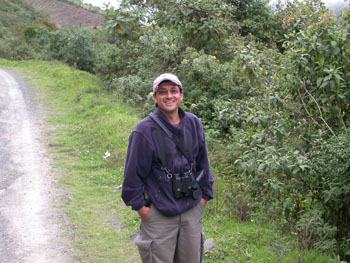 Our main guide, William Perez, met us at the airport and was with us from 5th to 21st January. Augusto was our driver in the north whilst we had Pedro in Loja and the south east. William was very good both at hearing and spotting birds we would otherwise have missed. His identification skills are excellent – there was only one call which had him confused for a while. He has an easy manner when dealing with people, was good company and invaluable to us as an interpreter. As well as working with Neblina, William guides independently and can be contacted by email. William now works with FieldGuides. Napo Wildlife Centre provided a local guide, Jorge Ribadeneira and a bird guide, Ruben Proano, for our stay there. Unfortunately the Napo guides were not exclusive to us all the time and when in a mixed party, the quality of birding deteriorated. Jorge was always very courteous and is an excellent spotter and finder of even the most skulking species. Ruben has been a wildlife guide for 10 years, a bird guide for the last 5 and by his own admission is still learning. Most species were identified correctly, but he seemed to rely heavily on Jorge at times. Again, it was good to have Ruben with us as an interpreter, although I think he has a way to go with inter-personal skills yet. Our main guide, William Perez, met us at the airport and was with us from 5th to 21st January. Augusto was our driver in the north whilst we had Pedro in Loja and the south east. William was very good both at hearing and spotting birds we would otherwise have missed. His identification skills are excellent – there was only one call which had him confused for a while. He has an easy manner when dealing with people, was good company and invaluable to us as an interpreter. As well as working with Neblina, William guides independently and can be contacted by email. William now works with FieldGuides. Napo Wildlife Centre provided a local guide, Jorge Ribadeneira and a bird guide, Ruben Proano, for our stay there. Unfortunately the Napo guides were not exclusive to us all the time and when in a mixed party, the quality of birding deteriorated. Jorge was always very courteous and is an excellent spotter and finder of even the most skulking species. Ruben has been a wildlife guide for 10 years, a bird guide for the last 5 and by his own admission is still learning. Most species were identified correctly, but he seemed to rely heavily on Jorge at times. Again, it was good to have Ruben with us as an interpreter, although I think he has a way to go with inter-personal skills yet.
Both bird guides (and others we saw) made extensive use of MP3 players for bird calls. When I first encountered this in Hungary eight years ago, I thought it was a brilliant idea to attract the more difficult, skulking species as long as used sensibly. 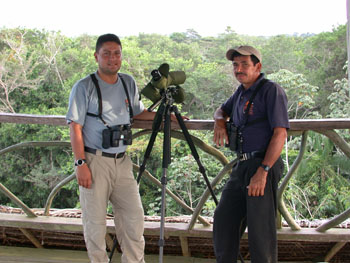 I am now beginning to wonder about the benefits – in Ecuador I reckon “taping” was less than 50% effective at producing a sighting. When I asked William he said he felt the percentage was about right, but if he were to go to a relatively new area, such as the Wildsumaco Lodge, success rates would soar. “Taping” appears to have become the easy option for some guides and over-use has perhaps resulted in birds becoming accustomed to playback and not “performing” on demand. One new innovation we found was the use of laser pointers to indicate the location of birds in the forest. It certainly improved the speed with which we were both able to acquire birds and meant we had longer to enjoy them before they moved on. This practice seems to be OK as long as the laser does not hit and scare the bird. I am now beginning to wonder about the benefits – in Ecuador I reckon “taping” was less than 50% effective at producing a sighting. When I asked William he said he felt the percentage was about right, but if he were to go to a relatively new area, such as the Wildsumaco Lodge, success rates would soar. “Taping” appears to have become the easy option for some guides and over-use has perhaps resulted in birds becoming accustomed to playback and not “performing” on demand. One new innovation we found was the use of laser pointers to indicate the location of birds in the forest. It certainly improved the speed with which we were both able to acquire birds and meant we had longer to enjoy them before they moved on. This practice seems to be OK as long as the laser does not hit and scare the bird.
Back to Index
COSTS
-
Business Class Flights £2340 each. Economy Flights were £746 each with KLM and £867 each with Iberia on 22nd November 2007 using Expedia.
-
Ground arrangements in Ecuador £3120 each to include: - All accommodation plus meals in all the lodges and in Loja. Private 4x4 vehicle and driver. Packed lunches & bottled water when appropriate. Local flights. Guide & driver expenses. All reserve/park entrance fees.
-
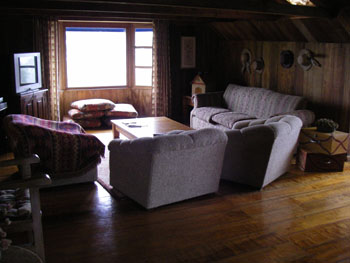 Dinner each evening in Quito (6 nights x cUS$50 (£25) per night, including beer and wine. Dinner each evening in Quito (6 nights x cUS$50 (£25) per night, including beer and wine.
-
Quito Airport Tax US$42 (£20) per person.
-
Tips
At the outset we specified we wanted the most comfortable lodges available and also good quality hotels. We were not particularly interested in keeping costs down and could have done the trip for much less, but as we tend to like our creature comforts the flights and accommodation were ideal for us.
Back to Index
RESEARCH & TRIP ESSENTIALS
  Brief info on everything for birding can be found on the Fatbirder web site. Brief info on everything for birding can be found on the Fatbirder web site.
A good selection of trip reports can also be found on the CloudBirders web site.
Recommended reading: - Ecuador and the Galapagos Islands (Lonely Planet Country Guide) - ISBN 1-74104-295-X. The Birds of Ecuador: Field Guide Vol 2 (Helm field guides) - ISBN 1-74104-295-X. The Birds of Ecuador: Field Guide Vol 2 (Helm field guides) by Ridgely and Greenfield - ISBN 0-7136-6117-8, Birds of Northern South America: An Identification Guide: Plates and Maps v. 2 (Helm Field Guides) by Restall, Rodner and Lentino - ISBN 0-7136-7243-9. by Ridgely and Greenfield - ISBN 0-7136-6117-8, Birds of Northern South America: An Identification Guide: Plates and Maps v. 2 (Helm Field Guides) by Restall, Rodner and Lentino - ISBN 0-7136-7243-9.
Currency: - US $
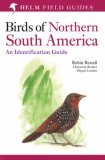  Health: - Appropriate protection is required for Diphtheria, Hepatitis A, Tetanus, Typhoid and Yellow Fever. Malaria is a risk throughout the year below 1500 metres. Malarone is the recommended protection and costing around £2 a tablet, does not come cheap. Protection was required for both the Choco and Amazon sections of the trip and with hindsight we would have arranged these two areas together to cut down on tablets (and possible side effects) as they need to be taken two days before entering a potential danger area and seven days after leaving. Mossie nets are provided in the Amazon and whilst there are lots of bugs in the forest, it’s not too bad when you’re on the water. Although liberally treated with insect repellent, we both ended up with lots of itching bites, especially around the ankles. Altitude Sickness is also a possibility, although we were never troubled by the height, other than getting a little out of breath when walking up steep slopes for any distance. Health: - Appropriate protection is required for Diphtheria, Hepatitis A, Tetanus, Typhoid and Yellow Fever. Malaria is a risk throughout the year below 1500 metres. Malarone is the recommended protection and costing around £2 a tablet, does not come cheap. Protection was required for both the Choco and Amazon sections of the trip and with hindsight we would have arranged these two areas together to cut down on tablets (and possible side effects) as they need to be taken two days before entering a potential danger area and seven days after leaving. Mossie nets are provided in the Amazon and whilst there are lots of bugs in the forest, it’s not too bad when you’re on the water. Although liberally treated with insect repellent, we both ended up with lots of itching bites, especially around the ankles. Altitude Sickness is also a possibility, although we were never troubled by the height, other than getting a little out of breath when walking up steep slopes for any distance.
  Climate: - Even in the dry seasons the weather can be changeable and both wellingtons/waterproof boots and ponchos/raingear are recommended, especially for the Amazon. Although we were there in the dry season, wellingtons were still essential on the trails. More information on what to expect throughout the year can be found in The Birds of Ecuador: Status, Distribution and Taxonomy Vol 1 Climate: - Even in the dry seasons the weather can be changeable and both wellingtons/waterproof boots and ponchos/raingear are recommended, especially for the Amazon. Although we were there in the dry season, wellingtons were still essential on the trails. More information on what to expect throughout the year can be found in The Birds of Ecuador: Status, Distribution and Taxonomy Vol 1 by Ridgely and Greenfield - ISBN 0-7136-6116-X. This volume also contains information on the various areas and their habitats as well as dealing with the status, distribution and taxonomy of the country’s birds. by Ridgely and Greenfield - ISBN 0-7136-6116-X. This volume also contains information on the various areas and their habitats as well as dealing with the status, distribution and taxonomy of the country’s birds.
Back to Index
WEATHER
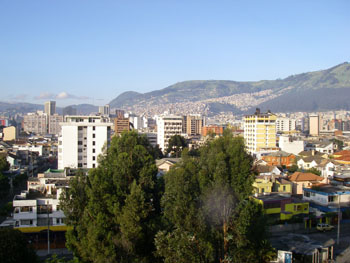 Quito was usually dry with a mixture of sunshine and low cloud. Travelling northwest to lower altitudes we saw quite a bit of persistent rain/drizzle around Milpe, Mindo and Bellavista. From Loja to Tapichalaca and beyond, we could nearly always see clouds and rain in the distance but we enjoyed unusually good, hot sunny weather most of the time we were there. Towards San Lorenzo on the Pacific coast the weather became hotter and more humid, although it didn’t rain quite as much as around Milpe. The first time we went over Papallacta Pass everywhere was shrouded in low cloud and it was noticeably colder. There was also quite a bit of persistent drizzle for a few hours each day. On our return four days later it was brighter and quite clear but there was a howling, freezing wind by the radio masts as we tried to relocate the 2 seedsnipes we had disturbed on our arrival. San Isidro was cool but clear most of the time with very little rain. Antisana was sunny and reasonably warm, as was Yanacocha early in the morning, until the usual mists rolled in at about 11.00, accompanied by a light drizzle for half an hour as we travelled the Nono-Mindo old road in the afternoon. The Amazon was hot and sticky but dry throughout, with lots of sunshine. Quito was usually dry with a mixture of sunshine and low cloud. Travelling northwest to lower altitudes we saw quite a bit of persistent rain/drizzle around Milpe, Mindo and Bellavista. From Loja to Tapichalaca and beyond, we could nearly always see clouds and rain in the distance but we enjoyed unusually good, hot sunny weather most of the time we were there. Towards San Lorenzo on the Pacific coast the weather became hotter and more humid, although it didn’t rain quite as much as around Milpe. The first time we went over Papallacta Pass everywhere was shrouded in low cloud and it was noticeably colder. There was also quite a bit of persistent drizzle for a few hours each day. On our return four days later it was brighter and quite clear but there was a howling, freezing wind by the radio masts as we tried to relocate the 2 seedsnipes we had disturbed on our arrival. San Isidro was cool but clear most of the time with very little rain. Antisana was sunny and reasonably warm, as was Yanacocha early in the morning, until the usual mists rolled in at about 11.00, accompanied by a light drizzle for half an hour as we travelled the Nono-Mindo old road in the afternoon. The Amazon was hot and sticky but dry throughout, with lots of sunshine.
Back to Index
ITINERARY
When we first started planning our itinerary, a trip to The Galapagos was firmly on the agenda, but I am an awful sailor and in the end we decided a severe bout of seasickness could spoil our holiday and to compensate, we substituted the Pacific north west “Choco” region and the inland south east Loja area to search for “Tumbesian” endemic species.
Day 1 - 5th Jan – Quito to Mindo via Calacali. o/n Sachatamia Lodge.
Day 2 - 6th Jan – Mindo road junction then Milpe. o/n Sachatamia Lodge.
Day 3 - 7th Jan – Refugio Angel Paz and Bellavista area. o/n Hotel Sebastian.
Day 4 - 8th Jan – Loja area and south via Vilcabamba. o/n Tapichalaca Lodge.
Day 5 - 9th Jan – Jocotoco Antpitta trail then Valladolid area. o/n Tapichalaca Lodge.
Day 6 - 10th Jan – Road to El Porvenir then back to Loja. o/n Hotel Libertador.
Day 7 - 11th Jan – San Lorenzo via Otavalo, Ibarra and Lita. o/n Tundaloma Lodge.
Day 8 - 12th Jan – Concepcion road and San Francisco area. o/n Tundaloma Lodge.
Day 9 - 13th Jan – Alto Tambo then road to Ricaute near lodge. o/n Tundaloma Lodge.
Day 10 - 14th Jan – Progreso Road then return to Quito. o/n Hotel Sebastian.
Day 11 - 15th Jan – Papallacta Pass. o/n Termas de Papallacta Lodge & Spa.
Day 12 - 16th Jan – San Isidro via Guango Lodge, Borja and Baeza. o/n Cabanas San Isidro.
Day 13 - 17th Jan – Full day around San Isidro area. o/n Cabanas San Isidro.
Day 14 - 18th Jan – Loreto Road. o/n Cabanas San Isidro.
Day 15 - 19th Jan – Guacamayos Ridge then Quito, via Papallacta. o/n Hotel Sebastian.
Day 16 - 20th Jan – Antisana Reserve. o/n Hotel Sebastian.
Day 17 - 21st Jan – Yanacocha returning via Nono-Mindo old road. o/n Hotel Sebastian.
Day 18 - 22nd Jan – Quito-Coca flight with VIP. o/n Napo Wildlife Centre.
Day 19 - 23rd Jan – Tiputini Trail plus canoe trip. o/n NWC.
Day 20 - 24th Jan – Forest Canopy Tower plus canoe trip. o/n NWC.
Day 21 - 25th Jan – Parrot clay licks plus Lodge Canopy Tower. o/n NWC.
Day 22 - 26th Jan – Flight to Quito. o/n Hotel Sebastian.
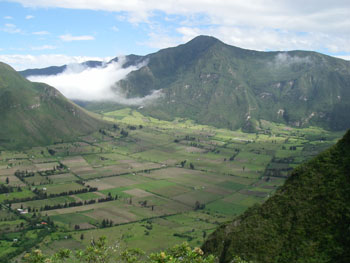 Day 23 - 27th Jan – Return to UK Day 23 - 27th Jan – Return to UK
Back to Index
DIARY and SITE REVIEW
Day 0: Friday 4th January 2008
Depart Manchester 19.20. Arrive Amsterdam 21.40. Depart 23.35 for Quito.
Day 1: Saturday 5th January
On arrival at Mariscal Sucre Airport in Quito (2800 metres) at 09.00 our guide, William Perez and driver, Augusto, were waiting to drive us out of the city towards the northwest slope and Mindo, along the Quito – Esmeraldas highway. Birding on the way, our first stop was at the Pululahua crater, a small National Park just outside Quito – great views but hardly any birds and too many tourists. We passed the new, very commercialised equatorial monument “Mitad del Mundo” and instead visited the original monument in the centre of Calacali. As we left the town we spotted some bird activity in a garden including Band-tailed Seedeater, Streak-throated Bush Tyrant, Scarlet-bellied Mountain Tanager, Southern Yellow Grosbeak and Ash-breasted Sierra-finch. 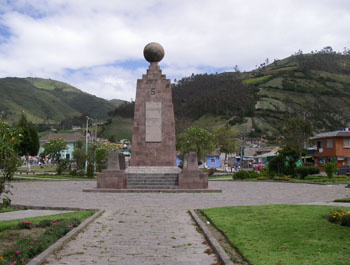 Moving on past the Nono road we stopped for a picnic lunch and picked up Cinereous Conebill, Rufous-chested Tanager and Azara’s Spinetail. It started to rain around 14.30 as we were heading towards Sachatamia Lodge (1500 metres) which is situated just off the highway and located in the heart of the subtropical cloud-forest. Numerous hummingbirds and tanagers crowded around the feeders despite the steady drizzle. Dusky Bush-Tanager, Rufous-chested Tanager, Purple-bibbed Whitetip, White-tailed Hillstar and Velvet-purple Coronet were the stars as we notched up 14 hummingbirds and 15 tanagers on our first day. At 16.30 we drove through Mindo and down to the river where we searched in vain for Fasciated Tiger-heron. We did however manage to see Rusty Margined Flycatcher, Golden-face Tyrannulet, White-capped Dipper, White-shouldered Tanager and Golden-headed Quetzal. We ended up with 69 species for the day; not bad, considering the time of our arrival and time spent getting on the road, travelling time and the rainy afternoon. Moving on past the Nono road we stopped for a picnic lunch and picked up Cinereous Conebill, Rufous-chested Tanager and Azara’s Spinetail. It started to rain around 14.30 as we were heading towards Sachatamia Lodge (1500 metres) which is situated just off the highway and located in the heart of the subtropical cloud-forest. Numerous hummingbirds and tanagers crowded around the feeders despite the steady drizzle. Dusky Bush-Tanager, Rufous-chested Tanager, Purple-bibbed Whitetip, White-tailed Hillstar and Velvet-purple Coronet were the stars as we notched up 14 hummingbirds and 15 tanagers on our first day. At 16.30 we drove through Mindo and down to the river where we searched in vain for Fasciated Tiger-heron. We did however manage to see Rusty Margined Flycatcher, Golden-face Tyrannulet, White-capped Dipper, White-shouldered Tanager and Golden-headed Quetzal. We ended up with 69 species for the day; not bad, considering the time of our arrival and time spent getting on the road, travelling time and the rainy afternoon.
Day 2: Sunday 6th January
At first light and before breakfast we set off down the Milpe Road to the Mindo junction to watch the frenzy of birds feeding on the moths and insects attracted to the lights there. Unfortunately, today the main light was out, but birds are creatures of habit and we were not disappointed. As we arrived at the junction a beautiful Black and White Owl was sitting on top of the huge roadside sign there, whilst a Short-tailed Nighthawk made the best of the early light to finish off the night’s feeding. Streak-capped Treehunter, Crimson-rumped Toucanet, Tricoloured Brush-finch, Sepia-brown Wren, Slaty Spinetail, Strong-billed Woodcreeper and Golden-crowned Flycatcher were just a few of the early morning appetisers. Returning to the Lodge we saw Brown Violetear, Buff-tailed Coronet and Green-crowned Brilliant before a leisurely breakfast.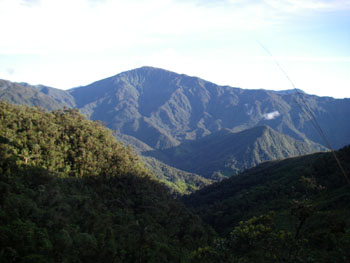 We then moved on to the Milpe Bird Sanctuary (1000 metres) owned by the Mindo Cloud-forest Foundation. We stopped the vehicle almost as soon as we turned off the highway down the approach road to Milpe as there were birds everywhere, despite a light drizzle. White-thighed Swallow, Yellow-collared Chlorophonia, Pale-mandibled Aracari, Sooty-headed Tyrannulet, Red-faced Spinetail, Rufous-throated Tanager, Yellow-throated Bush-tanager, Snowy-throated Kingbird, Swallow Tanager, Buff-fronted Foliage-gleaner and Black-winged Saltator all put in an appearance, whilst the first three, of many, magnificent Swallow-tailed Kite sailed overhead. The rain stopped as we progressed down the track but as we arrived at the Bird Sanctuary the heavens opened for 30 minutes. Relief was at hand – the Sanctuary has a small visitor centre providing coffee and toilet facilities and of course there were hummingbird feeders, where we saw Green-crowned Woodnymph, White-whiskered Hermit and Green Thorntail, amongst others. As the rain slackened off we headed for the trails and found Orange-billed Sparrow, Yellow Tyrannulet, Immaculate Antbird, Choco Warbler, Smoky Brown Woodpecker, both Golden-winged and Club-winged Manakin, plus Scaly-throated, Buff-fronted and Lineated Foliage Gleaner. We returned to the Lodge for lunch, during which William leaped up and ran outside, as somehow, he had spotted three Toucan Barbet land in the large tree opposite the front entrance, where they remained for a few minutes, enabling us to get excellent views. We then moved on to the Milpe Bird Sanctuary (1000 metres) owned by the Mindo Cloud-forest Foundation. We stopped the vehicle almost as soon as we turned off the highway down the approach road to Milpe as there were birds everywhere, despite a light drizzle. White-thighed Swallow, Yellow-collared Chlorophonia, Pale-mandibled Aracari, Sooty-headed Tyrannulet, Red-faced Spinetail, Rufous-throated Tanager, Yellow-throated Bush-tanager, Snowy-throated Kingbird, Swallow Tanager, Buff-fronted Foliage-gleaner and Black-winged Saltator all put in an appearance, whilst the first three, of many, magnificent Swallow-tailed Kite sailed overhead. The rain stopped as we progressed down the track but as we arrived at the Bird Sanctuary the heavens opened for 30 minutes. Relief was at hand – the Sanctuary has a small visitor centre providing coffee and toilet facilities and of course there were hummingbird feeders, where we saw Green-crowned Woodnymph, White-whiskered Hermit and Green Thorntail, amongst others. As the rain slackened off we headed for the trails and found Orange-billed Sparrow, Yellow Tyrannulet, Immaculate Antbird, Choco Warbler, Smoky Brown Woodpecker, both Golden-winged and Club-winged Manakin, plus Scaly-throated, Buff-fronted and Lineated Foliage Gleaner. We returned to the Lodge for lunch, during which William leaped up and ran outside, as somehow, he had spotted three Toucan Barbet land in the large tree opposite the front entrance, where they remained for a few minutes, enabling us to get excellent views.
Further along the main north western road, about 40 km beyond Sachatamia, is the Rio Silanche Bird Sanctuary near the town of Pedro Vicente Maldonado. The reserve is well known for the Choco endemics to be found there at the southern edge of their range and was originally on our itinerary. As we were heading to San Lorenzo and the heart of the Choco region later in our trip we decided our time in the area would be better spent with a return to Milpe after lunch, where we added Choco Toucan, One-coloured Becard, White-winged Becard, Arcadian Flycatcher, Maroon-tailed Parakeet, Spotted Woodcreeper and an excellent Spotted Nightingale-thrush. Despite the cloud cover the temperature was around 20°C for most of the day and apart from one downpour, there was a light drizzle on and off all day – apparently good birding weather as we had 108 species, taking our total to 144.
Day 3: Monday 7th January
Today we were out by 05.00 to visit the Refugio Paz de las Aves (1850 metres) to see Angel Paz and hopefully some antpittas. Please note visits must be pre-booked – see link. We arrived in the dark and with wellingtons and torches at the ready, set off for a 30 minute walk down a steep, rocky, slippery muddy path to the site’s Andean Cock-of-the-rock lek. It was still dark, deep in the forest, when we arrived at the small hide overlooking the lek. As dawn chased the night away we eventually picked up three male Cock-of-the-rock deep in the foliage about 30 metres away. Returning in the daylight towards the antpitta sites we saw 2 Rufous-bellied Nighthawk at their roost and a beautiful male Masked Trogon. “Maria” (the Giant Antpitta) was playing hard to get today and after waiting for well over 30 minutes, we were eventually asked to slip-slide down another steep, muddy, rocky path towards the river bed. Whilst waiting we were fortunate to pick up an Olivaceous Piha in the foliage overhead. 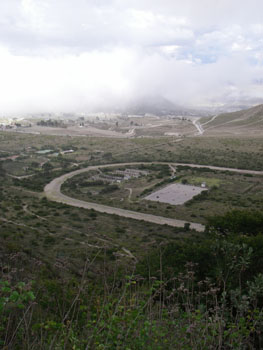 Down at the river we were finally successful with Giant Antpitta and moving along to another riverside site we saw a Yellow-breasted Antpitta (“Willy”). Re-tracing our steps back uphill towards another favoured site we saw Scaled Fruiteater, Black-chinned Mountain Tanager, 2 Capuchin Monkeys and “Shakira”, an Ochre-breasted Antpitta with a penchant for wiggling its rear end. Further up the hill we rested for a while at the hummingbird feeder station where we picked up Gorgeted Sunangel, Andean Solitaire and, a little further on, Yellow-faced Grassquit. Unfortunately photo opportunities were almost non-existent in the dark forested conditions, despite the proximity of the antpittas. Back at the old farmhouse in the car park area we had a late, local breakfast courtesy of the Paz family, before moving on to the Bellavista area (2000-2200 metres). As we made our first stop it started to rain; lightly at first but very quickly turning persistent. In worsening conditions we managed to see at least two Plate-billed Mountain Toucan. As we were eventually heading back to Quito the day nearly ended there at 13.00, but as we were passing Bellavista Lodge William came up with the idea of a stop at Tony’s house for the hummingbird feeders and our picnic lunch. This was an excellent idea: we were able to eat our lunch, seated comfortably under cover, under part of the property, whilst watching hummingbirds milling around the numerous feeders in the garden. Tony Nunnery, a Texan and his German wife Barbara have lived in Ecuador for a number of years and apparently, first brought the idea of hummingbird feeders to the area. Visitors are always made very welcome here, for a small fee to help with the cost of maintaining the feeders. In his “spare time” Tony guides tours for Victor Emmanuel Tours in South America. Whilst lunching we saw White-sided Flowerpiercer, Western Emerald, Brown Violetear and Rufous-winged Tyrannulet: moreover Tony took us around his “garden” to show us a Common Potoo at its daytime roost. Afterwards we returned to Quito via the Tandayapa valley and Calacali, where we once again stopped for some dry habitat birding and tried for the rare White-tailed Shrike-tyrant, without success; but we did pick up two male Black-tailed Trainbearer. Over the years the area around Bellavista and its forested valley has gained an impressive reputation for the quality and number of birds usually seen there. However with the weather very much against us, a fairly full morning spent at the antpitta reserve and Quito beckoning, we managed just 55 birds for the day. Down at the river we were finally successful with Giant Antpitta and moving along to another riverside site we saw a Yellow-breasted Antpitta (“Willy”). Re-tracing our steps back uphill towards another favoured site we saw Scaled Fruiteater, Black-chinned Mountain Tanager, 2 Capuchin Monkeys and “Shakira”, an Ochre-breasted Antpitta with a penchant for wiggling its rear end. Further up the hill we rested for a while at the hummingbird feeder station where we picked up Gorgeted Sunangel, Andean Solitaire and, a little further on, Yellow-faced Grassquit. Unfortunately photo opportunities were almost non-existent in the dark forested conditions, despite the proximity of the antpittas. Back at the old farmhouse in the car park area we had a late, local breakfast courtesy of the Paz family, before moving on to the Bellavista area (2000-2200 metres). As we made our first stop it started to rain; lightly at first but very quickly turning persistent. In worsening conditions we managed to see at least two Plate-billed Mountain Toucan. As we were eventually heading back to Quito the day nearly ended there at 13.00, but as we were passing Bellavista Lodge William came up with the idea of a stop at Tony’s house for the hummingbird feeders and our picnic lunch. This was an excellent idea: we were able to eat our lunch, seated comfortably under cover, under part of the property, whilst watching hummingbirds milling around the numerous feeders in the garden. Tony Nunnery, a Texan and his German wife Barbara have lived in Ecuador for a number of years and apparently, first brought the idea of hummingbird feeders to the area. Visitors are always made very welcome here, for a small fee to help with the cost of maintaining the feeders. In his “spare time” Tony guides tours for Victor Emmanuel Tours in South America. Whilst lunching we saw White-sided Flowerpiercer, Western Emerald, Brown Violetear and Rufous-winged Tyrannulet: moreover Tony took us around his “garden” to show us a Common Potoo at its daytime roost. Afterwards we returned to Quito via the Tandayapa valley and Calacali, where we once again stopped for some dry habitat birding and tried for the rare White-tailed Shrike-tyrant, without success; but we did pick up two male Black-tailed Trainbearer. Over the years the area around Bellavista and its forested valley has gained an impressive reputation for the quality and number of birds usually seen there. However with the weather very much against us, a fairly full morning spent at the antpitta reserve and Quito beckoning, we managed just 55 birds for the day.
Day 4: Tuesday 8th January
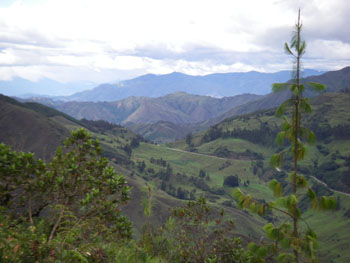 Another early start this morning – up at 04.30 and out by 05.45 – as our 50 minute flight from Quito to Loja departs just before 07.00. The alternative is a 700km drive taking between 11 and 12 hours. The area around Catamayo airport (1300 metres) near Loja is ideal birding terrain and having packed our cases in the back of our new driver Pedro’s vehicle, we were immediately on the lookout for Tumbesian endemics. Before we left the airport car park we had already picked up Saffron Finch, Croaking Ground-dove, Long-tailed Mockingbird, Peruvian Meadowlark and Pacific Pygmy Owl. After about 30 minutes we finally left the car park and moved on to a waste-land type site virtually across the road and under 1km away. Whilst there we met Santiago Hidalgo, whose family own the land, as well as sugar plantations in the area. Talking to Santiago was very interesting and he appeared to take his responsibilities to his workforce very seriously, as well as keeping his feet firmly on the ground. Although he was quite happy for us to explore the land, workmen were clearing a substantial area for a house to be built and access might not be so easy in the future. Driving along a track into a dry valley we got out of the vehicle and were rewarded with Tumbes Sparrow, Purple-collared Woodstar, Plumbeous-backed Thrush, Elegant Crescent-chest, Fasciated Wren, Tawny-crowned Pygmy Tyrant, Amazilia Hummingbird, Parrot-billed Seedeater and Collared Warbling-finch. We spent over an hour here and picked up some really good birds. We then left the site and returned to the paved road for a short while before tuning off on to a track, described as a short cut, which bypassed Loja (2000 metres) and headed towards the Podocarpus National Park. On the way we added Long-billed Starthroat, Rufous-browed Peppershrike, Collared Antshrike and Black-capped Sparrow. We drove down a track just before the town of Vilcabamba (1600 metres) to eat our picnic lunch, but the birds just wouldn’t stop coming: we saw Yellow-tailed Oriole, Glowing Puffleg and Blue-and-black Tanager before driving on towards Tapichalaca Reserve. Finally, a little tired after a very early start and a long drive on a hot sunny day, we arrived at the Lodge (2600 metres) which was built by the Jocotoco Foundation in the Tapichalaca Biological Reserve (2000-3100 metres). Before a light rain set in at 18.15 we had seen 6 new species of hummingbird at the feeders including Chestnut-breasted Coronet, Collared Inca and Rufous-capped Thornbill, plus Chestnut-capped Brush-finch, Citrine Warbler and Dusky Piha in the grounds around the Lodge. Another early start this morning – up at 04.30 and out by 05.45 – as our 50 minute flight from Quito to Loja departs just before 07.00. The alternative is a 700km drive taking between 11 and 12 hours. The area around Catamayo airport (1300 metres) near Loja is ideal birding terrain and having packed our cases in the back of our new driver Pedro’s vehicle, we were immediately on the lookout for Tumbesian endemics. Before we left the airport car park we had already picked up Saffron Finch, Croaking Ground-dove, Long-tailed Mockingbird, Peruvian Meadowlark and Pacific Pygmy Owl. After about 30 minutes we finally left the car park and moved on to a waste-land type site virtually across the road and under 1km away. Whilst there we met Santiago Hidalgo, whose family own the land, as well as sugar plantations in the area. Talking to Santiago was very interesting and he appeared to take his responsibilities to his workforce very seriously, as well as keeping his feet firmly on the ground. Although he was quite happy for us to explore the land, workmen were clearing a substantial area for a house to be built and access might not be so easy in the future. Driving along a track into a dry valley we got out of the vehicle and were rewarded with Tumbes Sparrow, Purple-collared Woodstar, Plumbeous-backed Thrush, Elegant Crescent-chest, Fasciated Wren, Tawny-crowned Pygmy Tyrant, Amazilia Hummingbird, Parrot-billed Seedeater and Collared Warbling-finch. We spent over an hour here and picked up some really good birds. We then left the site and returned to the paved road for a short while before tuning off on to a track, described as a short cut, which bypassed Loja (2000 metres) and headed towards the Podocarpus National Park. On the way we added Long-billed Starthroat, Rufous-browed Peppershrike, Collared Antshrike and Black-capped Sparrow. We drove down a track just before the town of Vilcabamba (1600 metres) to eat our picnic lunch, but the birds just wouldn’t stop coming: we saw Yellow-tailed Oriole, Glowing Puffleg and Blue-and-black Tanager before driving on towards Tapichalaca Reserve. Finally, a little tired after a very early start and a long drive on a hot sunny day, we arrived at the Lodge (2600 metres) which was built by the Jocotoco Foundation in the Tapichalaca Biological Reserve (2000-3100 metres). Before a light rain set in at 18.15 we had seen 6 new species of hummingbird at the feeders including Chestnut-breasted Coronet, Collared Inca and Rufous-capped Thornbill, plus Chestnut-capped Brush-finch, Citrine Warbler and Dusky Piha in the grounds around the Lodge.
Day 5: Wednesday 9th January
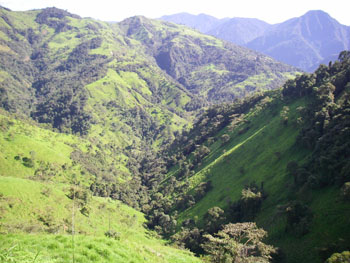 Franco, the Park Ranger at Tapichalaca, trained with Ángel Paz in Mindo and has subsequently developed a relationship with a pair of Jocotoco Antpitta which now come to the trail daily, looking for the worms that Franco collects for them. We set off early at 07.00 to see the antpittas and along the trail managed to pick up Rufous Spinetail, Black-throated Tody-Tyrant, Black-capped Hemispingus, Rufous Wren, Plushcap, Yellow-billed Cacique, Slate-crowned Antpitta and Orange-banded Flycatcher as well as the Jocotoco Antpitta pair. We returned to the Lodge for a leisurely breakfast, after which we set off along the Valladolid and Palanda road, which descends in less than half an hour, through a range of habitats to Valladolid (1,660 metres). On the way down the valley we had seen vultures and kites soaring on the thermals in the distance and as we reached Valladolid we were able to enjoy the spectacle of around 20 Swallow-tailed Kites gliding little more than 10 metres above our heads. Much to our surprise, especially after last night’s low cloud and rain, the day had dawned bright and clear and was well over 25°C by the time we arrived at our ultimate destination near Palanda. Roadside birding here produced Lined Antshrike, Streaked Saltator, Olive-chested Flycatcher, Merlin, Black-faced Tanager, Silver-backed Tanager, Highland Elaenia, Red-headed Barbet, Marañon Thrush, Silver-beaked Tanager, Rufous-fronted Thornbird, Grass-green Tanager and, very briefly, a Blackish Rail in flight. Returning to Tapichalaca Lodge around 17.00 we saw c15 Golden-plumed Parakeet circling the forested slopes above the Lodge and in the grounds we were paid a surprise visit by a Grey-breasted Mountain Toucan to round off a great days birding – only 63 species but some really special birds, taking our total for the trip to 253. Franco, the Park Ranger at Tapichalaca, trained with Ángel Paz in Mindo and has subsequently developed a relationship with a pair of Jocotoco Antpitta which now come to the trail daily, looking for the worms that Franco collects for them. We set off early at 07.00 to see the antpittas and along the trail managed to pick up Rufous Spinetail, Black-throated Tody-Tyrant, Black-capped Hemispingus, Rufous Wren, Plushcap, Yellow-billed Cacique, Slate-crowned Antpitta and Orange-banded Flycatcher as well as the Jocotoco Antpitta pair. We returned to the Lodge for a leisurely breakfast, after which we set off along the Valladolid and Palanda road, which descends in less than half an hour, through a range of habitats to Valladolid (1,660 metres). On the way down the valley we had seen vultures and kites soaring on the thermals in the distance and as we reached Valladolid we were able to enjoy the spectacle of around 20 Swallow-tailed Kites gliding little more than 10 metres above our heads. Much to our surprise, especially after last night’s low cloud and rain, the day had dawned bright and clear and was well over 25°C by the time we arrived at our ultimate destination near Palanda. Roadside birding here produced Lined Antshrike, Streaked Saltator, Olive-chested Flycatcher, Merlin, Black-faced Tanager, Silver-backed Tanager, Highland Elaenia, Red-headed Barbet, Marañon Thrush, Silver-beaked Tanager, Rufous-fronted Thornbird, Grass-green Tanager and, very briefly, a Blackish Rail in flight. Returning to Tapichalaca Lodge around 17.00 we saw c15 Golden-plumed Parakeet circling the forested slopes above the Lodge and in the grounds we were paid a surprise visit by a Grey-breasted Mountain Toucan to round off a great days birding – only 63 species but some really special birds, taking our total for the trip to 253.
Day 6: Thursday 10th January
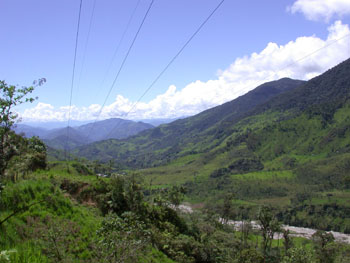 Much to everyone’s surprise the day dawned clear and sunny once again. Yesterday we had been told this only happened about 10 times a year and both the Lodge and surrounding hills had been covered in mist and low cloud for the previous two weeks, enjoying almost non-stop drizzle/rain. We made an early start with breakfast at 06.00 so we could drive via Valladolid towards El Porvenir on the edge of the Podocarpus National Park (1000 metres). Leaving Valladolid and heading east into the hills, over a very dubious bridge across the river in the valley bottom (construction work was taking place on a new bridge, adding to the poor quality of the road) we quickly entered woodland and found Metallic-green Tanager, Ashy-headed Tyrannulet, Sulphur-bellied Tyrannulet, Montane Foliage-gleaner, Ash-browed Spinetail, Streaked Xenops, Golden-collared Honeycreeper and Speckle-breasted Wren. As we wound our way slowly towards the National Park boundary the track was almost washed away in places; we were thankful for our 4 wheel drive, although local busses and lorries seemed to plough on regardless through the mire. We added White-eyed Parakeet, with a small flock of c8 birds, Steak-necked and Slaty-capped Flycatcher, Coppery-chested Jacamar and Yellow-browed Sparrow before turning around and heading back to the Lodge for lunch. We then began a leisurely journey back to Loja as we had an early flight to Quito the following day. On the way we had time to locate Glowing Puffleg, Rainbow Starfrontlet and Sierran Elaenia to give us 66 species for the day and take our list total to 273. Much to everyone’s surprise the day dawned clear and sunny once again. Yesterday we had been told this only happened about 10 times a year and both the Lodge and surrounding hills had been covered in mist and low cloud for the previous two weeks, enjoying almost non-stop drizzle/rain. We made an early start with breakfast at 06.00 so we could drive via Valladolid towards El Porvenir on the edge of the Podocarpus National Park (1000 metres). Leaving Valladolid and heading east into the hills, over a very dubious bridge across the river in the valley bottom (construction work was taking place on a new bridge, adding to the poor quality of the road) we quickly entered woodland and found Metallic-green Tanager, Ashy-headed Tyrannulet, Sulphur-bellied Tyrannulet, Montane Foliage-gleaner, Ash-browed Spinetail, Streaked Xenops, Golden-collared Honeycreeper and Speckle-breasted Wren. As we wound our way slowly towards the National Park boundary the track was almost washed away in places; we were thankful for our 4 wheel drive, although local busses and lorries seemed to plough on regardless through the mire. We added White-eyed Parakeet, with a small flock of c8 birds, Steak-necked and Slaty-capped Flycatcher, Coppery-chested Jacamar and Yellow-browed Sparrow before turning around and heading back to the Lodge for lunch. We then began a leisurely journey back to Loja as we had an early flight to Quito the following day. On the way we had time to locate Glowing Puffleg, Rainbow Starfrontlet and Sierran Elaenia to give us 66 species for the day and take our list total to 273.
Day 7: Friday 11th January
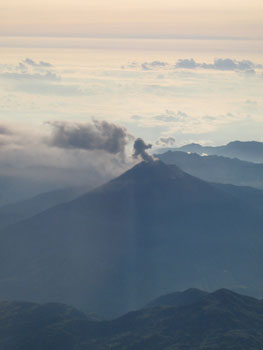 After an early wake up call we left the hotel at 05.30 and drove down to Catamayo to take the 07.15 flight to Quito. As we climbed the hills between Loja and the airport we were enveloped in thick fog/cloud and at times could hardly see more than 5 metres in front of us. Thankfully, as we approached the airport the sky cleared: after a quite “hairy” 45 minute drive we really appreciated having a driver who knew the local roads well. As we flew north along the Andes, we passed over the Tungurahua volcano which had started erupting a few days earlier and was to continue, with growing strength, throughout our stay in Ecuador. At the airport back in Quito we were met once again by Augusto, who was to be our driver until we left for the Amazon. We drove north out of town, taking the newly-paved Quito-Ibarra-San Lorenzo road which, in about five hours driving time, gives easy access to the threatened lowland rainforest of the north-west Choco region. Heading north we made our first stop at Laguna de San Pablo (2570 metres) at Otavalo, home of the famous Indian market town. In the shadow of the impressive Volcano Imbabura we picked up Southern Lapwing, Andean Coot, Pied-billed Grebe, Yellow-billed Pintail, Andean Ruddy Duck, a lone Laughing Gull, 2 Andean Rail, a pair of Vermillion Flycatcher, Common Moorhen and Subtropical Doradito. In the distance we saw several Yellowlegs Sp., but they were too far away to confirm which. Having seen all our target species for the area, we bypassed nearby Laguna de Yahuarcocha (2450 metres) and continued north to Ibarra, where we left the main road and turned west towards Lita (900 metres) and San Lorenzo. As the valley began to open out and sparse vegetation appeared we stopped where the old railway line crosses the road for the first time to walk down the disused tracks and added Tropical Mockingbird, Blue-headed Sapphire and Ruddy-breasted Seedeater to our list. A little further on we drove down a track on the left of the road towards a river to have our picnic lunch. On the way we saw Scrub Tanager, Red-eyed Vireo and, surprisingly, Tumbesian Tyrannulet as a small colony appears to have established itself here. Moving on down through the forested slopes we added Bat Falcon and Band-tailed Barbthroat before arriving at our destination, Tundaloma Lodge (60 metres) at about 16.15. After settling in to our room we went up to the bar for a welcome cold beer and added Olive-crowned Yellowthroat, Highland Hepatic Tanager, Esmeraldas Woodstar, Bronzy Hermit and Purple-crowned Fairy at the hummingbird feeders and in the trees around the Lodge. As dusk approached we decided to walk down to the nearby Tululbi River and came across White-throated Crake in the stream near the car park and an Osprey which came to roost on a nearby dead tree just across the water. Returning to the bar we heard Spectacled Owl, Choco Screech-owl and Pauraque calling; no luck with the owls unfortunately, but the Pauraque was hunting around the Lodge lights and landed on the path about 3 metres below the balcony where we stood, giving excellent torchlight views as it rested for a minute. We finished off with 80 species for the day, moving our list total on to 309. After an early wake up call we left the hotel at 05.30 and drove down to Catamayo to take the 07.15 flight to Quito. As we climbed the hills between Loja and the airport we were enveloped in thick fog/cloud and at times could hardly see more than 5 metres in front of us. Thankfully, as we approached the airport the sky cleared: after a quite “hairy” 45 minute drive we really appreciated having a driver who knew the local roads well. As we flew north along the Andes, we passed over the Tungurahua volcano which had started erupting a few days earlier and was to continue, with growing strength, throughout our stay in Ecuador. At the airport back in Quito we were met once again by Augusto, who was to be our driver until we left for the Amazon. We drove north out of town, taking the newly-paved Quito-Ibarra-San Lorenzo road which, in about five hours driving time, gives easy access to the threatened lowland rainforest of the north-west Choco region. Heading north we made our first stop at Laguna de San Pablo (2570 metres) at Otavalo, home of the famous Indian market town. In the shadow of the impressive Volcano Imbabura we picked up Southern Lapwing, Andean Coot, Pied-billed Grebe, Yellow-billed Pintail, Andean Ruddy Duck, a lone Laughing Gull, 2 Andean Rail, a pair of Vermillion Flycatcher, Common Moorhen and Subtropical Doradito. In the distance we saw several Yellowlegs Sp., but they were too far away to confirm which. Having seen all our target species for the area, we bypassed nearby Laguna de Yahuarcocha (2450 metres) and continued north to Ibarra, where we left the main road and turned west towards Lita (900 metres) and San Lorenzo. As the valley began to open out and sparse vegetation appeared we stopped where the old railway line crosses the road for the first time to walk down the disused tracks and added Tropical Mockingbird, Blue-headed Sapphire and Ruddy-breasted Seedeater to our list. A little further on we drove down a track on the left of the road towards a river to have our picnic lunch. On the way we saw Scrub Tanager, Red-eyed Vireo and, surprisingly, Tumbesian Tyrannulet as a small colony appears to have established itself here. Moving on down through the forested slopes we added Bat Falcon and Band-tailed Barbthroat before arriving at our destination, Tundaloma Lodge (60 metres) at about 16.15. After settling in to our room we went up to the bar for a welcome cold beer and added Olive-crowned Yellowthroat, Highland Hepatic Tanager, Esmeraldas Woodstar, Bronzy Hermit and Purple-crowned Fairy at the hummingbird feeders and in the trees around the Lodge. As dusk approached we decided to walk down to the nearby Tululbi River and came across White-throated Crake in the stream near the car park and an Osprey which came to roost on a nearby dead tree just across the water. Returning to the bar we heard Spectacled Owl, Choco Screech-owl and Pauraque calling; no luck with the owls unfortunately, but the Pauraque was hunting around the Lodge lights and landed on the path about 3 metres below the balcony where we stood, giving excellent torchlight views as it rested for a minute. We finished off with 80 species for the day, moving our list total on to 309.
Day 8: Saturday 12th January
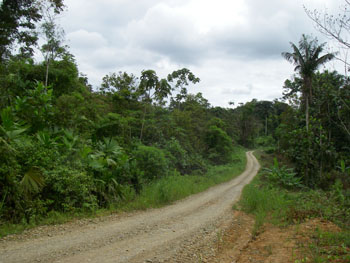 Today we were out by first light, shortly after 06.15 for a pre breakfast walk around the Lodge grounds. We were rewarded with 3 Chestnut-mandibled Toucan almost as soon as we left the car park, closely followed by Red-billed Scythebill, Violet-bellied Hummingbird, Red-legged Honeycreeper and both male and female Pacific Antwren. After returning to the Lodge at 08.00 for a leisurely breakfast we drove a short distance to the Concepcion old road and walked several lengthy stretches of the logging road/track. As we got out of the vehicle at our first stop a Grey-headed Kite was sitting quietly on top of a nearby dead tree. Setting the tone for the day, this was quickly followed by Slaty Becard, Black-crowned Tytyra, a pair of Blue Ground Dove, Long-tailed Tyrant, Black-tipped Cotinga, Black-striped Woodcreeper, Purple Honeycreeper, Stripe-throated Wren, Dusky Pigeon, a pair of Purple-throated Fruitcrow and a pair of Black-capped Pygmy-Tyrant. Moving further along the track we encountered Blue Dacnis, Fulvous-vented Euphonia, Olive-striped Flycatcher, Scarlet-breasted Dacnis, Tawny-crested Tanager and a magnificent male Guayaquil Woodpecker. After midday we returned for lunch at the Lodge and after chilling out for a couple of hours we went back out to an area a little higher up the main road near the small town of San Francisco (100 metres). Although the day was dull and overcast, it remained dry and ideal for birding. As we moved between different altitudes and habitats the number of new species continued to grow and in the late afternoon we added a pair of White-bearded Manakin, Rufous-tailed Jacamar, a pair of Blue Cotinga, Black-breasted Puffbird, Dusky-faced Tanager, 3 male Tawny-crested Tanager, Yellow-margined Flatbill, Brown-capped Tyrannulet, Lesser Greenlet, 3 Blue-whiskered Tanager, Olive-sided Flycatcher, Cinnamon Woodpecker, Yellow-tufted Dacnis and Scaled Pigeon. We returned to the Lodge at 17.45 for some well deserved liquid refreshment with 82 birds for the day and 356 species in total. Today we were out by first light, shortly after 06.15 for a pre breakfast walk around the Lodge grounds. We were rewarded with 3 Chestnut-mandibled Toucan almost as soon as we left the car park, closely followed by Red-billed Scythebill, Violet-bellied Hummingbird, Red-legged Honeycreeper and both male and female Pacific Antwren. After returning to the Lodge at 08.00 for a leisurely breakfast we drove a short distance to the Concepcion old road and walked several lengthy stretches of the logging road/track. As we got out of the vehicle at our first stop a Grey-headed Kite was sitting quietly on top of a nearby dead tree. Setting the tone for the day, this was quickly followed by Slaty Becard, Black-crowned Tytyra, a pair of Blue Ground Dove, Long-tailed Tyrant, Black-tipped Cotinga, Black-striped Woodcreeper, Purple Honeycreeper, Stripe-throated Wren, Dusky Pigeon, a pair of Purple-throated Fruitcrow and a pair of Black-capped Pygmy-Tyrant. Moving further along the track we encountered Blue Dacnis, Fulvous-vented Euphonia, Olive-striped Flycatcher, Scarlet-breasted Dacnis, Tawny-crested Tanager and a magnificent male Guayaquil Woodpecker. After midday we returned for lunch at the Lodge and after chilling out for a couple of hours we went back out to an area a little higher up the main road near the small town of San Francisco (100 metres). Although the day was dull and overcast, it remained dry and ideal for birding. As we moved between different altitudes and habitats the number of new species continued to grow and in the late afternoon we added a pair of White-bearded Manakin, Rufous-tailed Jacamar, a pair of Blue Cotinga, Black-breasted Puffbird, Dusky-faced Tanager, 3 male Tawny-crested Tanager, Yellow-margined Flatbill, Brown-capped Tyrannulet, Lesser Greenlet, 3 Blue-whiskered Tanager, Olive-sided Flycatcher, Cinnamon Woodpecker, Yellow-tufted Dacnis and Scaled Pigeon. We returned to the Lodge at 17.45 for some well deserved liquid refreshment with 82 birds for the day and 356 species in total.
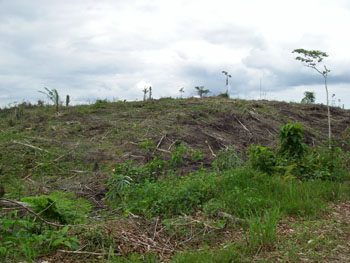 Great swathes of the areas we travelled through today had been devastated by logging and forest clearance for either palm plantations or agriculture. In the main, palms are planted first and worked for 15-20 years after which they cease to be economically viable; the land is then usually given over to agriculture and cattle. It is heartbreaking to see the vast areas of wildlife friendly pristine forest given over to relatively sterile palm plantations. At Christmas 2006 my sister-in-law gave us a Certificate confirming she had made a gift to the World Land Trust Action Fund to purchase and protect two acres of threatened tropical forest in Ecuador on our behalf. Seeing the devastation caused by logging in the Choco forest brought new meaning to this gift, as on our travels we passed the Rio Canade reserve being established by the Jocotoco Foundation, WLT’s partner organisation in Ecuador. Great swathes of the areas we travelled through today had been devastated by logging and forest clearance for either palm plantations or agriculture. In the main, palms are planted first and worked for 15-20 years after which they cease to be economically viable; the land is then usually given over to agriculture and cattle. It is heartbreaking to see the vast areas of wildlife friendly pristine forest given over to relatively sterile palm plantations. At Christmas 2006 my sister-in-law gave us a Certificate confirming she had made a gift to the World Land Trust Action Fund to purchase and protect two acres of threatened tropical forest in Ecuador on our behalf. Seeing the devastation caused by logging in the Choco forest brought new meaning to this gift, as on our travels we passed the Rio Canade reserve being established by the Jocotoco Foundation, WLT’s partner organisation in Ecuador.
Day 9: Sunday 13th January
After an early breakfast at 06.00 we were out by 06.45 heading for Alto Tambo (250-350 metres) and beyond, towards the foothills for some roadside birding at higher altitudes, initially from 450-600 metres, looking for some of the tanagers that had so far eluded us. Scarlet-browed and Ochre-breasted Tanager led the way in a mixed flock of up to 6 species. Grey-and-gold, Silver-throated and Emerald Tanager, plus Bay Wren and Double-toothed Kite quickly followed. The day was overcast with occasional drizzle, but birding conditions were ideal. As we moved up to 700-800 metres Scarlet-and-White Tanager, 4 Buff-rumped Warbler and Choco Trogon were amongst several species moving around a forest clearing near the ponds of a small fish farm. 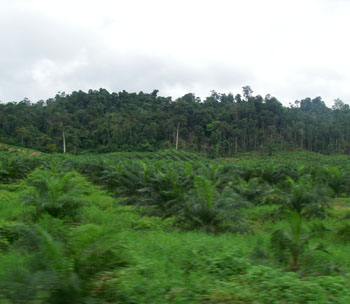 Slightly higher up we came across Broad-billed Motmot, Wedge-billed Woodcreeper, Yellow-crowned Tyrannulet and Band Backed Wren, as well as Bat Falcon, perched on the same dead tree near the side of the road as on the late afternoon two days previously, when we were first driving down to the coastal lowlands. We then retraced our steps back to the Lodge for lunch at 13.00. With the weather continuing overcast but dry we headed out at 15.00 along a track off the main road towards nearby Ricaute. There were lots of birds about, including many we had already picked up since arriving in the area. New species included Red-capped Manakin, 2 Laughing Falcon, Great Antshrike, Western Slaty-Antshrike, Rufous Mourner, Dusky Antbird and Slaty-tailed Trogon, together with much better views of a Little Cuckoo, previously seen briefly in flight on the river near the Lodge on the day we arrived. On returning to the main road, as we drove the short distance back to the Lodge, a White-tailed Kite drifted lazily above the vehicle and we were able to stop at the side of the road to watch the bird quarter the adjacent fields for a few minutes before it slowly sailed off into the surrounding woodland. Another 85 species seen today with the trip list rising to 378. Slightly higher up we came across Broad-billed Motmot, Wedge-billed Woodcreeper, Yellow-crowned Tyrannulet and Band Backed Wren, as well as Bat Falcon, perched on the same dead tree near the side of the road as on the late afternoon two days previously, when we were first driving down to the coastal lowlands. We then retraced our steps back to the Lodge for lunch at 13.00. With the weather continuing overcast but dry we headed out at 15.00 along a track off the main road towards nearby Ricaute. There were lots of birds about, including many we had already picked up since arriving in the area. New species included Red-capped Manakin, 2 Laughing Falcon, Great Antshrike, Western Slaty-Antshrike, Rufous Mourner, Dusky Antbird and Slaty-tailed Trogon, together with much better views of a Little Cuckoo, previously seen briefly in flight on the river near the Lodge on the day we arrived. On returning to the main road, as we drove the short distance back to the Lodge, a White-tailed Kite drifted lazily above the vehicle and we were able to stop at the side of the road to watch the bird quarter the adjacent fields for a few minutes before it slowly sailed off into the surrounding woodland. Another 85 species seen today with the trip list rising to 378.
Day 10: Monday 14th January
Today was our last day in the Choco region and we intended to make an early start to make the best of our remaining time here, before heading southeast out of San Lorenzo and back to Quito, after lunch at the Lodge. We had breakfast at 06.00 but we were surrounded by low cloud and it was raining quite heavily, as it had done for most of the night. We took the opportunity to pack and chill out for a while and only set out at 07.40 as the rain was easing off. We travelled the short distance to the logging road/track heading towards Progreso, hoping to locate some of the species we had missed when we spent some time in a similar habitat on the 12th. For the first hour or so the rain fell steadily ensuring we continued to make good use of our ponchos. Almost as annoying as the rain was a Blue-black Grosbeak, calling persistently at the roadside, but remaining unseen despite our best efforts for 15 minutes. As the rain eased off and stopped altogether at around 09.30 our disregard for the adverse conditions was rewarded with a super pair of Lineated Woodpecker, Green Manakin, Dot-winged Antwren, a male Black-tipped Cotinga, Striped Cuckoo, both White-whiskered and Stripe-throated Hermit and Orange-fronted Barbet. As we were driving back, we stopped to remove a tortoise from the track and saw 2 Red Howler Monkey sunning themselves in the treetops, no doubt drying out after the rain. Returning to the Lodge for lunch and our cases, we set off at 13.00 for our 300km/5 hour drive back to Quito. In view of the time spent birding in the morning and the fact we had picked up the majority of the target species along the road, we only made two brief stops to stretch our legs on the way back. Using a similar logic, we had decided not to visit Las Peñas on the coast, where we could have probably added another 40+ species (gulls, terns and waders) to our trip list. In the main these would not have been lifers for us and we decided to opt for quality over quantity. We only saw 43 species today but our trip list still moved along to 384.
Day 11: Tuesday 15th January
We had a lie-in today with breakfast at 06.45 and were picked up at our hotel at 07.30 to drive up over the eastern ridge of the Andes and down to Papallacta, the gateway to the Amazon Basin and not far from the source of the Napo River, Ecuador’s largest Amazon tributary. Normally the road offers splendid views of several snow-capped peaks as it winds its way over the Papallacta Pass (4000 metres – 14800 feet), but not today! Everywhere was shrouded in cloud and mist and, from time to time, persistent drizzle. 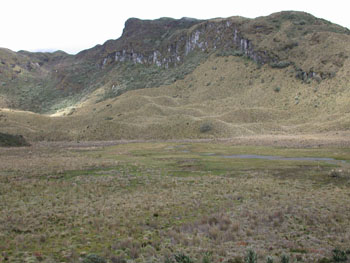 The journey is only 87kms and takes about 1 hour 30 minutes, but as can be expected, we made numerous stops along the way and took a major detour from the paved road, along the old “road” towards the summit. We eventually arrived at our destination at 13.45, having had a picnic lunch on the way. At our first stop (c3000 metres) on a roadside track leading to a small wooded valley, we soon picked up Giant Hummingbird, Rusty Flowerpiercer, Green-tailed Trainbearer, Red-crested Cotinga, Plain-colored Seedeater, Black-crested Warbler and Shining Sunbeam. We then took a detour onto the old road (term used very loosely for a twisting, rutted, rocky track) and as we gained height, came across a flock of c20 Andean Gull in a freshly ploughed field and several South American Rabbit. Our next stop (c3600 metres) yielded a Tawny Antpitta in the roadside grass, Black-winged Ground-Dove, Plumbeous Sierra-Finch, a stunning pair of Red-rumped Bush-Tyrant, a pair of Andean Tit-Spinetail and Many-striped Canastero. We took the opportunity to have our picnic lunch whilst William walked off to the nearby patches of stunted Polylepis woodland trying to locate Giant Conebill; unfortunately without success, the mist and rainy conditions didn’t help of course. The journey is only 87kms and takes about 1 hour 30 minutes, but as can be expected, we made numerous stops along the way and took a major detour from the paved road, along the old “road” towards the summit. We eventually arrived at our destination at 13.45, having had a picnic lunch on the way. At our first stop (c3000 metres) on a roadside track leading to a small wooded valley, we soon picked up Giant Hummingbird, Rusty Flowerpiercer, Green-tailed Trainbearer, Red-crested Cotinga, Plain-colored Seedeater, Black-crested Warbler and Shining Sunbeam. We then took a detour onto the old road (term used very loosely for a twisting, rutted, rocky track) and as we gained height, came across a flock of c20 Andean Gull in a freshly ploughed field and several South American Rabbit. Our next stop (c3600 metres) yielded a Tawny Antpitta in the roadside grass, Black-winged Ground-Dove, Plumbeous Sierra-Finch, a stunning pair of Red-rumped Bush-Tyrant, a pair of Andean Tit-Spinetail and Many-striped Canastero. We took the opportunity to have our picnic lunch whilst William walked off to the nearby patches of stunted Polylepis woodland trying to locate Giant Conebill; unfortunately without success, the mist and rainy conditions didn’t help of course.
As we were driving along I noticed a large raptor coming out of the cloud and soaring over the crags which had briefly appeared around us. Amidst screeching brakes we all piled out of the vehicle, just in time to see Andean Condor drifting away from us back into the cloud. As we rejoined the paved road at the top of the Pass, visibility was so poor there was just no point heading up to the radio masts on the summit to try for the seedsnipes. We did however manage to see a pair of Paramo Tapaculo, Viridian Metaltail, Black-backed Bush-Tanager and Brown-backed Chat-Tyrant, before dropping down to the Termas de Papallacta Lodge & Spa (3200 metres). As we neared our destination, we saw Andean Teal on a small lake beside the track leading to the Lodge. With time to kill, hoping the clouds and drizzle would go away, before we went out again at 15.30 I decided to try out the Spa’s hot springs. It was so relaxing I nearly missed a Black-chested Buzzard-Eagle as it drifted low overhead. Unfortunately the clouds and intermittent drizzle persisted as we later drove a short distance up the hillside track above the Lodge. Although we were out for 2 hours it was pretty quiet overall, but we did manage to see Andean Pygmy Owl and Mountain Velvetbreast before returning to the Lodge for dinner and one of the worst night’s sleep of the trip. We only saw 46 species today, but, moving through different habitat and altitude zones, we added 23 to our list to give a running total of 407.
Day 12: Wednesday 16th January
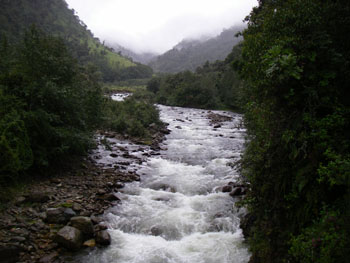 We decided to explore the trail above Termas once again before breakfast to try and locate some of species we had missed the previous afternoon in the temperate forest typical of the area. After the previous night, Amanda opted for a lie-in, but I was out at 06.00 to survey the remains of yesterday evening’s low cloud and rain. Not much change really, but as we were already up we decided to proceed and hope the weather improved. The mist and rain eventually relented a little and we were able to find Superciliaried Hemispingus, Blue-backed Conebill, Buff-breasted Mountain-Tanager, White-throated Tyrannulet, Pale-naped Brush-Finch, White-browed Spinetail and Great Sapphirewing, giving due reward for our efforts. We also saw Tawny Antpitta again, at the side of the road as was yesterday’s, but despite hearing at least two Rufous Antpitta, sounding almost close enough to touch (also like yesterday on the same track), we were unable to locate them. After breakfast at 08.00 we set off down towards the Amazon basin and with lush vegetation soon beginning to blanket the valley sides, we again moved into a different habitat thereby enhancing the potential for new species. After about 20 minutes we stopped at Guango Lodge (2700 metres) and almost immediately, at the hummingbird feeders, saw both male and female of one of our target birds, Sword-billed Hummingbird (a species with the longest bill in relation to body length of any bird in the world), together with Tourmaline Sunangel and 8 other hummingbird species. We then donned our ponchos and wellingtons (you guessed it…the rain had returned) and set off down one of the Lodge’s trails and almost immediately came across a beautiful-looking Weasel (Mustella frenata), much larger and more graceful than our weasel species. We also managed to find Slaty Brush-Finch and a pair of Torrent Duck on the fast flowing river in the valley bottom. Returning to the Lodge for lunch, William found our 11th hummingbird species – Mountain Avocetbill. At 14.00 after an excellent lunch and just as the rain stopped, we continued on our way. We decided to explore the trail above Termas once again before breakfast to try and locate some of species we had missed the previous afternoon in the temperate forest typical of the area. After the previous night, Amanda opted for a lie-in, but I was out at 06.00 to survey the remains of yesterday evening’s low cloud and rain. Not much change really, but as we were already up we decided to proceed and hope the weather improved. The mist and rain eventually relented a little and we were able to find Superciliaried Hemispingus, Blue-backed Conebill, Buff-breasted Mountain-Tanager, White-throated Tyrannulet, Pale-naped Brush-Finch, White-browed Spinetail and Great Sapphirewing, giving due reward for our efforts. We also saw Tawny Antpitta again, at the side of the road as was yesterday’s, but despite hearing at least two Rufous Antpitta, sounding almost close enough to touch (also like yesterday on the same track), we were unable to locate them. After breakfast at 08.00 we set off down towards the Amazon basin and with lush vegetation soon beginning to blanket the valley sides, we again moved into a different habitat thereby enhancing the potential for new species. After about 20 minutes we stopped at Guango Lodge (2700 metres) and almost immediately, at the hummingbird feeders, saw both male and female of one of our target birds, Sword-billed Hummingbird (a species with the longest bill in relation to body length of any bird in the world), together with Tourmaline Sunangel and 8 other hummingbird species. We then donned our ponchos and wellingtons (you guessed it…the rain had returned) and set off down one of the Lodge’s trails and almost immediately came across a beautiful-looking Weasel (Mustella frenata), much larger and more graceful than our weasel species. We also managed to find Slaty Brush-Finch and a pair of Torrent Duck on the fast flowing river in the valley bottom. Returning to the Lodge for lunch, William found our 11th hummingbird species – Mountain Avocetbill. At 14.00 after an excellent lunch and just as the rain stopped, we continued on our way.
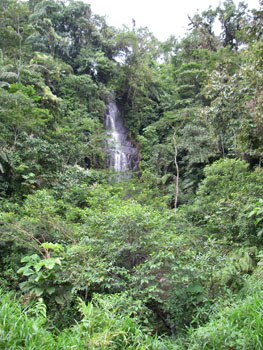 The eastern Andean slope is quite picturesque, with several tumbling waterfalls and small villages and a whole new range of species to look for. Added to this, the sun was shining…where could we go wrong? As we approached the town of Baeza we came to a road junction where we took the left fork along the road to Coca rather than the right fork to Tena. Initially we smiled at the long queue of stationary traffic on the Tena road but within 1 km we were stopped ourselves, the third vehicle in a queue, just too late to get across the only bridge over the river which had been closed by the local district work force who appeared desperate to effect some minor repairs. Typically, one man seemed to be directing operations whilst another carried out the work and four colleagues chatted to each other and pointed at the road and bridge from time to time. As time went by tempers either side of the bridge frayed, drivers started sounding their horns and the occasional comedian went up the wrong lane to get around the queues, only to have to turn around and having lost his place, go further back in line. The more people got agitated, the more the workmen seemed intent on taking their time. One entrepreneur got out of his vehicle carrying a tray of drinks and snacks and wandered up and down the traffic on both sides of the bridge. This performance went on for about an hour and with long streams of traffic either side of the bridge, which was single track, it was evident whoever got off the mark first and started crossing the bridge, the other side would have to wait for a further 15-20 minutes before getting their chance to cross. Initially the odds were in our favour, as head of our queue and much nearer to the coned off bridge than his opponent on the other side, was a local bus. After we had been waiting about 45 minutes a police car pulled up on the other side of the bridge; the constabulary got out, surveyed the scene, went and talked to the workmen and then stationed themselves at the head of the queue with intent. Having been in the lead 1-0 we suddenly went 1-3 down and things weren’t looking too good. Just as the workmen were packing away their tools and blow-torches and movement was afoot to remove the cones, an ambulance came rapidly down our side of the road with its siren blaring – two own goals and a stunning last minute winner: 4-3 to us! The eastern Andean slope is quite picturesque, with several tumbling waterfalls and small villages and a whole new range of species to look for. Added to this, the sun was shining…where could we go wrong? As we approached the town of Baeza we came to a road junction where we took the left fork along the road to Coca rather than the right fork to Tena. Initially we smiled at the long queue of stationary traffic on the Tena road but within 1 km we were stopped ourselves, the third vehicle in a queue, just too late to get across the only bridge over the river which had been closed by the local district work force who appeared desperate to effect some minor repairs. Typically, one man seemed to be directing operations whilst another carried out the work and four colleagues chatted to each other and pointed at the road and bridge from time to time. As time went by tempers either side of the bridge frayed, drivers started sounding their horns and the occasional comedian went up the wrong lane to get around the queues, only to have to turn around and having lost his place, go further back in line. The more people got agitated, the more the workmen seemed intent on taking their time. One entrepreneur got out of his vehicle carrying a tray of drinks and snacks and wandered up and down the traffic on both sides of the bridge. This performance went on for about an hour and with long streams of traffic either side of the bridge, which was single track, it was evident whoever got off the mark first and started crossing the bridge, the other side would have to wait for a further 15-20 minutes before getting their chance to cross. Initially the odds were in our favour, as head of our queue and much nearer to the coned off bridge than his opponent on the other side, was a local bus. After we had been waiting about 45 minutes a police car pulled up on the other side of the bridge; the constabulary got out, surveyed the scene, went and talked to the workmen and then stationed themselves at the head of the queue with intent. Having been in the lead 1-0 we suddenly went 1-3 down and things weren’t looking too good. Just as the workmen were packing away their tools and blow-torches and movement was afoot to remove the cones, an ambulance came rapidly down our side of the road with its siren blaring – two own goals and a stunning last minute winner: 4-3 to us!
After a further 5/6 kms along the Coca road we turned right near the town of Borja and cut back along a track to the Cosanga/Tena road on the other side of Baeza (1700 metres). The area is given over to agriculture with open pastures surrounded by thick woodland and ideal for our target species here, Red-breasted Blackbird, and almost immediately we found two pristine males sat on fence posts, just like the book says they should. A number of other good species followed in quick succession, including Chestnut-bellied Seedeater, Golden Olive Woodpecker, 2 Torrent Duck (this time both females), a pair of Cock-of-the-Rock (of the reddish-orange eastern race), Ash-browed Spinetail, Orange-eared Tanager, Barred Becard, Golden-eared Tanager, Black-and-white Seedeater and Black-billed Thrush. We finally arrived at Cabanas San Isidro (1900-2200 metres), in the heart of the mountain forest, with the enticing prospect of good views of 2/3 owls, one of which is a potential new species still awaiting DNA confirmation. We ended the day with 69 species and a total list of 430, despite drawing a blank on the owls in our searches both before and after dinner.
Day 13: Thursday 17th January
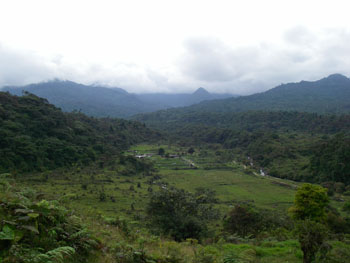 We were out at 06.00 to catch the early birds attracted to the lights on the track leading down to San Isidro’s dining room. Enjoying the feast of moths and insects here were Black-billed Peppershrike, Common Bush-Tanager, Olive-backed Woodcreeper, Black-eared Hemispingus, White-tailed Tyrannulet, Canada Warbler, Grey-breasted Wood Wren and Russet-crowned Warbler. Around 07.30 we wandered down two of the forest trails with one of the wardens and a can of worms and eventually managed to see a very shy White-bellied Antpitta which had been calling in the nearby undergrowth for over 15 minutes. In view of the delay, another warden had already gone along the second trail and as we walked up to him a Chestnut-crowned Antpitta was already out on the path feeding. The ease with which these formerly skulking birds are now being seen is amazing. We returned to the dining room at 08.00 for breakfast and then, suitably refreshed, we drove and walked along the track which carries on past San Isidro. Habitat here is a mixture of woodland and sparse vegetation surrounding small settlements where land has been cleared for pasture. Birds were not plentiful but we managed to see Streaked Tuftedcheek, White-throated Quail-dove, a pair of territorial and very noisy White-capped Tanager and Rufous-crowned Tody-Tyrant. We went as far as the Rio Aliso where we picked up White-sided Flowerpiercer and a pair of Torrent Tyrannulet. We started back around 12.00 and there was a light drizzle for about 20 minutes as we watched a small flock of c13 Southern Lapwing feeding in the pasture being disturbed by some grazing cattle. We were out at 06.00 to catch the early birds attracted to the lights on the track leading down to San Isidro’s dining room. Enjoying the feast of moths and insects here were Black-billed Peppershrike, Common Bush-Tanager, Olive-backed Woodcreeper, Black-eared Hemispingus, White-tailed Tyrannulet, Canada Warbler, Grey-breasted Wood Wren and Russet-crowned Warbler. Around 07.30 we wandered down two of the forest trails with one of the wardens and a can of worms and eventually managed to see a very shy White-bellied Antpitta which had been calling in the nearby undergrowth for over 15 minutes. In view of the delay, another warden had already gone along the second trail and as we walked up to him a Chestnut-crowned Antpitta was already out on the path feeding. The ease with which these formerly skulking birds are now being seen is amazing. We returned to the dining room at 08.00 for breakfast and then, suitably refreshed, we drove and walked along the track which carries on past San Isidro. Habitat here is a mixture of woodland and sparse vegetation surrounding small settlements where land has been cleared for pasture. Birds were not plentiful but we managed to see Streaked Tuftedcheek, White-throated Quail-dove, a pair of territorial and very noisy White-capped Tanager and Rufous-crowned Tody-Tyrant. We went as far as the Rio Aliso where we picked up White-sided Flowerpiercer and a pair of Torrent Tyrannulet. We started back around 12.00 and there was a light drizzle for about 20 minutes as we watched a small flock of c13 Southern Lapwing feeding in the pasture being disturbed by some grazing cattle.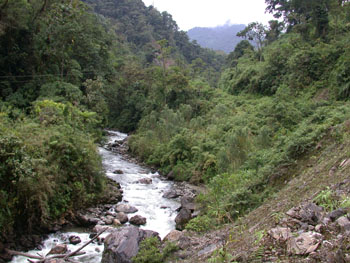 As we returned to San Isidro for lunch we came across Rufous-breasted Flycatcher, Long-tailed Antbird, a very photogenic Masked Trogon, Pale-edged Flycatcher and Bluish Flowerpiercer. In the late afternoon we headed back in the direction of Baeza and took a track to Santa Lucia, along the Rio Bermejo valley. Although the area was quite quiet we did manage to find c6 White-capped Parrot (previously only seen by Amanda and William at Tony’s house), a stunning male Powerful Woodpecker and a Highland Motmot perched on a boulder at the side of the fast flowing river. As dusk approached we drove back to the main road and continued for a short while towards Baeza, stopping at some roadside craggy slopes to look for nightjars. When you are waiting for the light to fade into darkness it seems to take ages: William played tapes and searched the slopes and sky with his flashlight for well over 30 minutes without any luck. It was now well after 19.00 and with dinner waiting back at the Lodge we gave up and got back in the vehicle. As we drove off William heard a bird calling and we all piled out again desperately scanning the skyline; we eventually managed brief glimpses of a female/juvenile Lyre-tailed Nightjar hunting overhead. Back at the Lodge we briefly saw Rufous-banded Owl fly away from one of its favourite roosts on the driveway as it was disturbed by our headlights. We continued on foot hoping to see the not-yet-described San Isidro “mystery’ Owl and were rewarded with good views of a juvenile perched just above our heads in a small tree. After dinner we had excellent views of an adult, similarly perched, as we walked back to our cabin, rounding off a relatively slow day with only 61 species, but 24 of these were new, taking our total to 454. As we returned to San Isidro for lunch we came across Rufous-breasted Flycatcher, Long-tailed Antbird, a very photogenic Masked Trogon, Pale-edged Flycatcher and Bluish Flowerpiercer. In the late afternoon we headed back in the direction of Baeza and took a track to Santa Lucia, along the Rio Bermejo valley. Although the area was quite quiet we did manage to find c6 White-capped Parrot (previously only seen by Amanda and William at Tony’s house), a stunning male Powerful Woodpecker and a Highland Motmot perched on a boulder at the side of the fast flowing river. As dusk approached we drove back to the main road and continued for a short while towards Baeza, stopping at some roadside craggy slopes to look for nightjars. When you are waiting for the light to fade into darkness it seems to take ages: William played tapes and searched the slopes and sky with his flashlight for well over 30 minutes without any luck. It was now well after 19.00 and with dinner waiting back at the Lodge we gave up and got back in the vehicle. As we drove off William heard a bird calling and we all piled out again desperately scanning the skyline; we eventually managed brief glimpses of a female/juvenile Lyre-tailed Nightjar hunting overhead. Back at the Lodge we briefly saw Rufous-banded Owl fly away from one of its favourite roosts on the driveway as it was disturbed by our headlights. We continued on foot hoping to see the not-yet-described San Isidro “mystery’ Owl and were rewarded with good views of a juvenile perched just above our heads in a small tree. After dinner we had excellent views of an adult, similarly perched, as we walked back to our cabin, rounding off a relatively slow day with only 61 species, but 24 of these were new, taking our total to 454.
Day 14: Friday 18th January
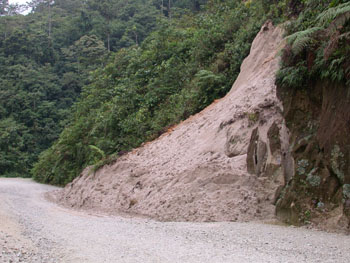 We had an early morning start today with breakfast at 06.00 enabling us to arrive at a reasonable time at our main destination, the Loreto road (1300 metres), before the day heated up too much. Here many of the most important eastern foothills species can be found birding from the roadside. Once over the Guacamayos ridge the paved road disappears for a time, becoming a muddy, slippery track which is prone to landslips during periods of heavy rainfall. Maintenance crews were out on two separate stretches of the road trying to strengthen crumbling sections where the road was in danger of slipping down the hillside. Yet again the benefits of being in a 4x4 vehicle were brought home to us. Our first brief stop brought us a calling Crested Quetzal which briefly flew across the road in front of us, Streak-necked Flycatcher, White-tailed Hillstar and Black-mandibled Toucan. We arrived at the road junction where the Loreto/Coca road splits from the main Tena road and started birding as soon as we had left the small settlement behind us. There were birds all around and we immediately picked up several new species including Little Woodpecker, a pair of Red-headed Barbet, Yellow-tufted Woodpecker, a small flock of Magpie Tanager, Lesser Swallow-tailed Swift, Violaceous Jay, Crested Oropendola, Spot-breasted Woodpecker, Olivaceous Greenlet, Black-tailed Tytyra and Glittering-throated Emerald. We moved on a few kilometres, descending slowly and encountered a pair of Golden-collared Toucanet with a feisty male displaying for about 20 minutes. As we walked further down the road we picked up Scale-crested Pygmy-Tyrant, Golden-eyed Flowerpiercer, Spotted Tanager, Crimson-crested Woodpecker, Wire-crested Thorntail, White-lored Euphonia, Channel-billed Toucan, Grayish Saltator and a pair of very vocal Coraya Wren. We also had much better views of Orange-eared and Golden-eared Tanager than we had two days previously as we arrived in the San Isidro area. We had an early morning start today with breakfast at 06.00 enabling us to arrive at a reasonable time at our main destination, the Loreto road (1300 metres), before the day heated up too much. Here many of the most important eastern foothills species can be found birding from the roadside. Once over the Guacamayos ridge the paved road disappears for a time, becoming a muddy, slippery track which is prone to landslips during periods of heavy rainfall. Maintenance crews were out on two separate stretches of the road trying to strengthen crumbling sections where the road was in danger of slipping down the hillside. Yet again the benefits of being in a 4x4 vehicle were brought home to us. Our first brief stop brought us a calling Crested Quetzal which briefly flew across the road in front of us, Streak-necked Flycatcher, White-tailed Hillstar and Black-mandibled Toucan. We arrived at the road junction where the Loreto/Coca road splits from the main Tena road and started birding as soon as we had left the small settlement behind us. There were birds all around and we immediately picked up several new species including Little Woodpecker, a pair of Red-headed Barbet, Yellow-tufted Woodpecker, a small flock of Magpie Tanager, Lesser Swallow-tailed Swift, Violaceous Jay, Crested Oropendola, Spot-breasted Woodpecker, Olivaceous Greenlet, Black-tailed Tytyra and Glittering-throated Emerald. We moved on a few kilometres, descending slowly and encountered a pair of Golden-collared Toucanet with a feisty male displaying for about 20 minutes. As we walked further down the road we picked up Scale-crested Pygmy-Tyrant, Golden-eyed Flowerpiercer, Spotted Tanager, Crimson-crested Woodpecker, Wire-crested Thorntail, White-lored Euphonia, Channel-billed Toucan, Grayish Saltator and a pair of very vocal Coraya Wren. We also had much better views of Orange-eared and Golden-eared Tanager than we had two days previously as we arrived in the San Isidro area.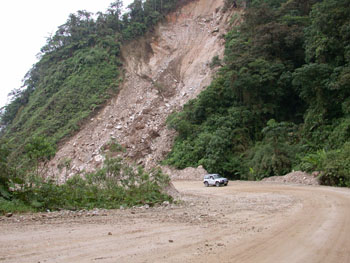 After a picnic lunch, by a bridge over the river as we reached the valley bottom, we moved on another few kilometres to a site where the hillside had been quarried away by the locals for use on the road surface. Here we saw Cliff Flycatcher, Olivaceous Woodcreeper, Lafresnaye’s Piculet, Yellow-whiskered Bush-Tanager and both Turquoise and Paradise Tanager. We retraced our steps back along Loreto road and as we neared the junction by the small settlement at the start of the road we saw a pair of stunning Black-capped Donacobius on the roadside wires. As we went back up into the hills towards San Isidro we stopped again to try for better views of the Crested Quetzal seen earlier, but to no avail. We did however come across a Bronze-green Euphonia in flight and several mixed flocks of tanagers including Rufous-crested Tanager and 3 stunning Vermillion Tanager, before heading off into the mist and rain which was blanketing the higher ground. We got back to the Lodge at 16.45 and saw the usual array of hummingbirds around the feeders; 8 different species, but nothing new. We finished one of the best day’s birding of the trip with 93 species adding 33 new birds to our trip list which had now moved on to 487. After a picnic lunch, by a bridge over the river as we reached the valley bottom, we moved on another few kilometres to a site where the hillside had been quarried away by the locals for use on the road surface. Here we saw Cliff Flycatcher, Olivaceous Woodcreeper, Lafresnaye’s Piculet, Yellow-whiskered Bush-Tanager and both Turquoise and Paradise Tanager. We retraced our steps back along Loreto road and as we neared the junction by the small settlement at the start of the road we saw a pair of stunning Black-capped Donacobius on the roadside wires. As we went back up into the hills towards San Isidro we stopped again to try for better views of the Crested Quetzal seen earlier, but to no avail. We did however come across a Bronze-green Euphonia in flight and several mixed flocks of tanagers including Rufous-crested Tanager and 3 stunning Vermillion Tanager, before heading off into the mist and rain which was blanketing the higher ground. We got back to the Lodge at 16.45 and saw the usual array of hummingbirds around the feeders; 8 different species, but nothing new. We finished one of the best day’s birding of the trip with 93 species adding 33 new birds to our trip list which had now moved on to 487.
Day 15: Saturday 19th January
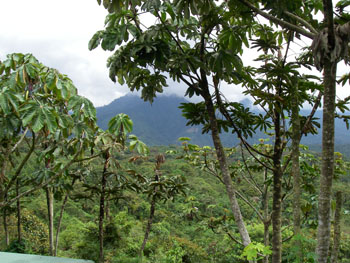 Back in our cabin after an early breakfast at 06.00 I stood on our little balcony for a few minutes as I had heard a Highland Motmot calling. The bird flew into the canopy to within 4 metres and perched in the open for 30 seconds: you never have a camera handy when you really need one! We then set off along the Tena road to the Guacamayos Ridge (2200 metres) to explore the trail by the National Park sign where the road goes over the top of the ridge. As we arrived the mist descended and it started to rain – ponchos and wellingtons once again. In far from ideal conditions, there were not many birds about and quite a few of those calling wouldn’t show themselves. However, we did manage to get good views of Black-billed Mountain Toucan, Green-and-Black Fruiteater, Rufous-headed Pygmy-Tyrant and Tawny-bellied Hermit, prior to returning to the Lodge at 10.30 having only covered a little over 1 km of the trail before turning back. With lunch scheduled for 12.30 and the weather having brightened up as soon as we started descending towards San Isidro, we spent some time at the hummingbird feeders and managed to pick up Golden-rumped Euphonia in the tops of the surrounding trees, as well as getting much better/closer views of the Tawny-bellied Hermit. As we were eating lunch another party came in to the dining room saying they had just been watching a pair of Solitary Eagle soaring over the nearby hillside. William and I dashed out to the end of the Lodge driveway, but to no avail; the eagles had disappeared and we were left breathless and dreaming about what might have been. At 13.00 we left San Isidro heading back to Quito via Papallacta and back up into the páramo, hoping for better weather than on our previous visit. Back in our cabin after an early breakfast at 06.00 I stood on our little balcony for a few minutes as I had heard a Highland Motmot calling. The bird flew into the canopy to within 4 metres and perched in the open for 30 seconds: you never have a camera handy when you really need one! We then set off along the Tena road to the Guacamayos Ridge (2200 metres) to explore the trail by the National Park sign where the road goes over the top of the ridge. As we arrived the mist descended and it started to rain – ponchos and wellingtons once again. In far from ideal conditions, there were not many birds about and quite a few of those calling wouldn’t show themselves. However, we did manage to get good views of Black-billed Mountain Toucan, Green-and-Black Fruiteater, Rufous-headed Pygmy-Tyrant and Tawny-bellied Hermit, prior to returning to the Lodge at 10.30 having only covered a little over 1 km of the trail before turning back. With lunch scheduled for 12.30 and the weather having brightened up as soon as we started descending towards San Isidro, we spent some time at the hummingbird feeders and managed to pick up Golden-rumped Euphonia in the tops of the surrounding trees, as well as getting much better/closer views of the Tawny-bellied Hermit. As we were eating lunch another party came in to the dining room saying they had just been watching a pair of Solitary Eagle soaring over the nearby hillside. William and I dashed out to the end of the Lodge driveway, but to no avail; the eagles had disappeared and we were left breathless and dreaming about what might have been. At 13.00 we left San Isidro heading back to Quito via Papallacta and back up into the páramo, hoping for better weather than on our previous visit. 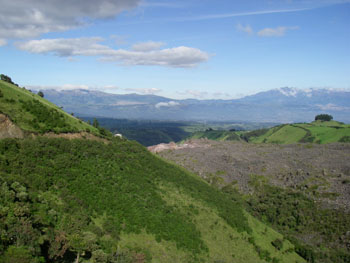 The mountain tops were covered in shifting clouds, but it was much clearer and brighter today and on our way to the summit by the radio masts (4200 metres) we picked up White-chinned Thistletail and a pair of Paramo Ground-Tyrant. Having driven to the masts, William walked to the edge of the area behind the buildings and disturbed 2 Rufous-bellied Seedsnipe on the slope just below his feet. They flew off, calling, around the buildings to the other side of the track where we saw them land just over a little bank, but despite a thorough search we were unable to relocate them. The clouds continued to drift around the peak and the freezing cold wind gusting around us meant we only looked for about 20 minutes before heading off lower (and just before Amanda and I lost the will to live). On the way back to the main road we saw both Bar-winged and Stout-billed Cinclodes, as well as an Ecuadorian Hillstar in flight. Just 44 species today but we did manage to add 11 new birds to our total which now stood at 498. The mountain tops were covered in shifting clouds, but it was much clearer and brighter today and on our way to the summit by the radio masts (4200 metres) we picked up White-chinned Thistletail and a pair of Paramo Ground-Tyrant. Having driven to the masts, William walked to the edge of the area behind the buildings and disturbed 2 Rufous-bellied Seedsnipe on the slope just below his feet. They flew off, calling, around the buildings to the other side of the track where we saw them land just over a little bank, but despite a thorough search we were unable to relocate them. The clouds continued to drift around the peak and the freezing cold wind gusting around us meant we only looked for about 20 minutes before heading off lower (and just before Amanda and I lost the will to live). On the way back to the main road we saw both Bar-winged and Stout-billed Cinclodes, as well as an Ecuadorian Hillstar in flight. Just 44 species today but we did manage to add 11 new birds to our total which now stood at 498.
Day 16: Sunday 20th January
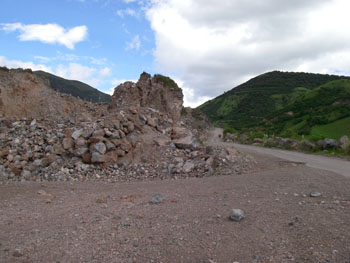 Another lie-in today, we were picked up at the Hotel Sebastian at 07.15 and set off up to the mountains through the Los Chillos Valley towards the Antisana Ecological Reserve (3800 metres) in beautiful clear sunshine. The journey is about 40 kms and would take 1 hour 30 minutes non-stop. When Antisana last erupted, about 200 years ago, the lava flow stretched for 6 kms towards Quito, blocking off and filling many upland valleys on the way. Our first stop was on top of the leading edge of the lava flow overlooking a steep sided wooded valley. The locals have been mining the lava for years to provide both building and road-making materials and the residue makes for a spectacular landscape. Birds seen around here included 3 Giant Hummingbird, two of which were actually together, the first of many Carunculated Caracara and an Andean Condor. As we drove along we were surrounded by a flock of c500 Hooded Siskin feeding in the grassy meadows and roadside verges. We then stopped by a bridge over a fast flowing mountain stream and were able to watch up to 6 female Ecuadorian Hillstar both at rest and flirting around their territories. Before we left we eventually located a singing Grass Wren skulking in the low bushes and had excellent views as it eventually decided to come out into the open and enjoy the sunshine. We also had stunning extended views of a Black-chested Buzzard-Eagle as it repeatedly harassed and was then chased by a pair of Carunculated Caracara. Another lie-in today, we were picked up at the Hotel Sebastian at 07.15 and set off up to the mountains through the Los Chillos Valley towards the Antisana Ecological Reserve (3800 metres) in beautiful clear sunshine. The journey is about 40 kms and would take 1 hour 30 minutes non-stop. When Antisana last erupted, about 200 years ago, the lava flow stretched for 6 kms towards Quito, blocking off and filling many upland valleys on the way. Our first stop was on top of the leading edge of the lava flow overlooking a steep sided wooded valley. The locals have been mining the lava for years to provide both building and road-making materials and the residue makes for a spectacular landscape. Birds seen around here included 3 Giant Hummingbird, two of which were actually together, the first of many Carunculated Caracara and an Andean Condor. As we drove along we were surrounded by a flock of c500 Hooded Siskin feeding in the grassy meadows and roadside verges. We then stopped by a bridge over a fast flowing mountain stream and were able to watch up to 6 female Ecuadorian Hillstar both at rest and flirting around their territories. Before we left we eventually located a singing Grass Wren skulking in the low bushes and had excellent views as it eventually decided to come out into the open and enjoy the sunshine. We also had stunning extended views of a Black-chested Buzzard-Eagle as it repeatedly harassed and was then chased by a pair of Carunculated Caracara. 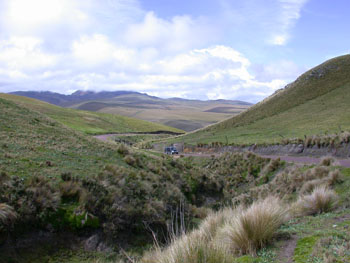 Paramo Pipit and Streak-backed Canastero also put in an appearance as we gained height and it became much cooler, despite the sunshine. Eventually the area flattens out into a lush paramo where Antisana volcano (5704 metres) appears almost close enough to touch. On a clear day the active Cotopaxi volcano is also visible, but today, it was surrounded by cloud. Here we saw a single endangered Black-faced Ibis and a pair of Andean Lapwing amongst hundreds of Andean Gull and Carunculated Caracara. We drove on to Laguna La Mica where, despite the week-end crowd of anglers and sightseers braving the cold wind, we managed to see a solitary Lesser Yellowlegs and 2 Silvery Grebe. After a picnic lunch, we tried in vain to locate the elusive Aplomado Falcon, as we first drove the track towards the volcano and then slowly started on our way back to Quito. Amanda did however spot 2 White-tailed Deer grazing on a nearby ridge and our second Andean Condor of the day. As we lost height William spotted a Curve-billed Tinamou right by the roadside in a ploughed field. The bird slowly moved away as we stopped, but then remained motionless as 2 caracaras landed on the edge of the field. We were back in Quito by 16.00. In the highlands, although new specialist species appear, bird numbers dwindle and not surprisingly we only managed 34 species for the day, but our total kept moving on to 510. Paramo Pipit and Streak-backed Canastero also put in an appearance as we gained height and it became much cooler, despite the sunshine. Eventually the area flattens out into a lush paramo where Antisana volcano (5704 metres) appears almost close enough to touch. On a clear day the active Cotopaxi volcano is also visible, but today, it was surrounded by cloud. Here we saw a single endangered Black-faced Ibis and a pair of Andean Lapwing amongst hundreds of Andean Gull and Carunculated Caracara. We drove on to Laguna La Mica where, despite the week-end crowd of anglers and sightseers braving the cold wind, we managed to see a solitary Lesser Yellowlegs and 2 Silvery Grebe. After a picnic lunch, we tried in vain to locate the elusive Aplomado Falcon, as we first drove the track towards the volcano and then slowly started on our way back to Quito. Amanda did however spot 2 White-tailed Deer grazing on a nearby ridge and our second Andean Condor of the day. As we lost height William spotted a Curve-billed Tinamou right by the roadside in a ploughed field. The bird slowly moved away as we stopped, but then remained motionless as 2 caracaras landed on the edge of the field. We were back in Quito by 16.00. In the highlands, although new specialist species appear, bird numbers dwindle and not surprisingly we only managed 34 species for the day, but our total kept moving on to 510.
Day 17: Monday 21st January
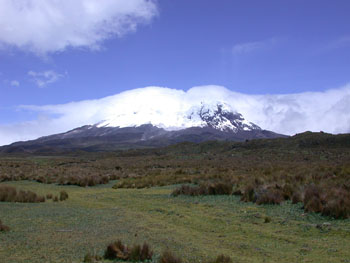 Pick up at the hotel this morning was 06.30 as we set off to drive 30 km up out of Quito towards Yanacocha (3200-3600 metres), an area of moss-clad temperate forest on the slopes of Volcano Pichincha. The drive took 1 hour 20 minutes, as the paved road quickly gives way to a rutted track on the outskirts of the city. When we arrived it was sunny, but cold, with clear skies. There is a picnic area with toilet facilities at the entrance to the reserve, with further facilities about 1½ miles along the trail. At first birds were quite vocal, but difficult to locate. Soon however we were watching Glossy Flowerpiercer, 3 Stripe-headed Brush-Finch, a pair of Black-chested Mountain-Tanager, Barred Fruiteater, Crowned Chat-Tyrant and Sapphire-vented Puffleg, plus an Undulated Antpitta which flew across the path in front of us and annoyingly, began calling, but would not put in a further appearance. At 09.30 the mist/cloud for which the area is notorious in the late morning, suddenly appeared out of nowhere and enveloped us for a while; no rain this time however. Male and female Bar-bellied Woodpecker appeared out of the mist after calling in the distance and as conditions improved a little, we reached the hummingbird feeders near the toilet facilities, where we were able to enjoy once again the delightful Sword-billed Hummingbird and the large, almost bat-like, Great Sapphirewing. Moving on a little further, higher up the trail we came across Golden-breasted Puffleg which appears to favour the slightly higher altitude within the shadow of the Pichincha volcano. Pick up at the hotel this morning was 06.30 as we set off to drive 30 km up out of Quito towards Yanacocha (3200-3600 metres), an area of moss-clad temperate forest on the slopes of Volcano Pichincha. The drive took 1 hour 20 minutes, as the paved road quickly gives way to a rutted track on the outskirts of the city. When we arrived it was sunny, but cold, with clear skies. There is a picnic area with toilet facilities at the entrance to the reserve, with further facilities about 1½ miles along the trail. At first birds were quite vocal, but difficult to locate. Soon however we were watching Glossy Flowerpiercer, 3 Stripe-headed Brush-Finch, a pair of Black-chested Mountain-Tanager, Barred Fruiteater, Crowned Chat-Tyrant and Sapphire-vented Puffleg, plus an Undulated Antpitta which flew across the path in front of us and annoyingly, began calling, but would not put in a further appearance. At 09.30 the mist/cloud for which the area is notorious in the late morning, suddenly appeared out of nowhere and enveloped us for a while; no rain this time however. Male and female Bar-bellied Woodpecker appeared out of the mist after calling in the distance and as conditions improved a little, we reached the hummingbird feeders near the toilet facilities, where we were able to enjoy once again the delightful Sword-billed Hummingbird and the large, almost bat-like, Great Sapphirewing. Moving on a little further, higher up the trail we came across Golden-breasted Puffleg which appears to favour the slightly higher altitude within the shadow of the Pichincha volcano. 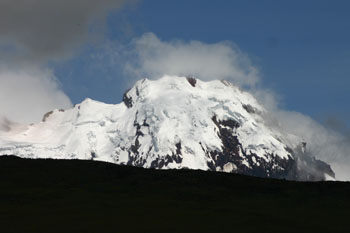 We retraced our steps for a picnic lunch by the car park at 12.00 and then headed down the other side of Yanacocha towards the Nono-Mindo old road, which we eventually joined, having seen a stunning pair of Crimson-mantled Woodpecker on the way. Above Nono we were hoping to locate White-winged Brush-Finch, but our luck was out; we heard them calling nearby and saw dark blobs moving about in the heart of the bushes, but that was the best we could do. Not to be disappointed, we added Plain-tailed Wren and Blackish Tapaculo, before heading back to Quito and taking our final leave (or so we thought at the time) of William and our driver Augusto, back at the Hotel Sebastian at 16.40. We finished the day with 46 species, 12 of which were new, to finish this section of our trip with a grand total of 522. As, initially, we were expecting about 550 species for the whole trip, we were pleased with our efforts to date and, off to the Amazon tomorrow, where Napo Wildlife Centre has a bird list of over 560 species, we had visions of exceeding 650 overall. We retraced our steps for a picnic lunch by the car park at 12.00 and then headed down the other side of Yanacocha towards the Nono-Mindo old road, which we eventually joined, having seen a stunning pair of Crimson-mantled Woodpecker on the way. Above Nono we were hoping to locate White-winged Brush-Finch, but our luck was out; we heard them calling nearby and saw dark blobs moving about in the heart of the bushes, but that was the best we could do. Not to be disappointed, we added Plain-tailed Wren and Blackish Tapaculo, before heading back to Quito and taking our final leave (or so we thought at the time) of William and our driver Augusto, back at the Hotel Sebastian at 16.40. We finished the day with 46 species, 12 of which were new, to finish this section of our trip with a grand total of 522. As, initially, we were expecting about 550 species for the whole trip, we were pleased with our efforts to date and, off to the Amazon tomorrow, where Napo Wildlife Centre has a bird list of over 560 species, we had visions of exceeding 650 overall.
Day 18: Tuesday 22nd January
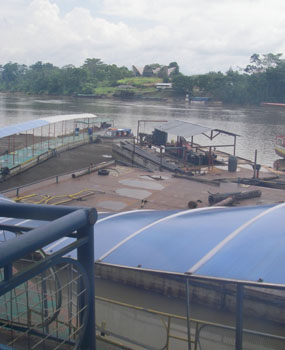 Another lie-in (such luxury!), we were picked up at the hotel at 09.30 and taken to the airport for our 30 minute flight over the Andes to Coca (300 metres). By road the 150 km journey takes over 6 hours and, with flights reasonably priced, there was no competition as far as we were concerned. We had arranged to leave our cases at Hotel Sebastian whilst we went to the Amazon and we just packed essentials in a canvas holdall we had brought with us just for this purpose. At the airport we were met by Napo’s Quito representative who dealt with our luggage and all check-in formalities. We also met Ruben, who was to be our bird guide and interpreter in the jungle. The hot, humid air hit us as soon as we stepped from the plane in Coca and we were taxied from the airport down to the river, along with several other people who were also going to Napo Wildlife Centre (NWC). We boarded a covered motorized canoe for a 2½ hour, 70 km journey down the Napo river and had lunch en-route. The river is Ecuador’s principal Amazon tributary and about 1/3 of a mile wide here. The waters are sediment-rich and during the dry season huge sandbanks are exposed making navigation quite tricky in places, with huge submerged tree trunks wedged in the silt adding an extra degree of difficulty. As we were leaving the dock a Yellow-headed Caracara drifted over the river and although we didn’t stop for any birds, we managed to see Cocoi Heron and Swallow-winged Puffbird along with several egrets and vultures. As we were about to leave the Napo we saw 6 Pied Lapwing and an Oriole Blackbird on a nearby sandbank. The weather on the river was overcast with occasional bursts of sunshine. Rain threatened once but soon cleared away. Travelling at speed you don’t notice the heat until the boat slows down as you arrive at your destination. Another lie-in (such luxury!), we were picked up at the hotel at 09.30 and taken to the airport for our 30 minute flight over the Andes to Coca (300 metres). By road the 150 km journey takes over 6 hours and, with flights reasonably priced, there was no competition as far as we were concerned. We had arranged to leave our cases at Hotel Sebastian whilst we went to the Amazon and we just packed essentials in a canvas holdall we had brought with us just for this purpose. At the airport we were met by Napo’s Quito representative who dealt with our luggage and all check-in formalities. We also met Ruben, who was to be our bird guide and interpreter in the jungle. The hot, humid air hit us as soon as we stepped from the plane in Coca and we were taxied from the airport down to the river, along with several other people who were also going to Napo Wildlife Centre (NWC). We boarded a covered motorized canoe for a 2½ hour, 70 km journey down the Napo river and had lunch en-route. The river is Ecuador’s principal Amazon tributary and about 1/3 of a mile wide here. The waters are sediment-rich and during the dry season huge sandbanks are exposed making navigation quite tricky in places, with huge submerged tree trunks wedged in the silt adding an extra degree of difficulty. As we were leaving the dock a Yellow-headed Caracara drifted over the river and although we didn’t stop for any birds, we managed to see Cocoi Heron and Swallow-winged Puffbird along with several egrets and vultures. As we were about to leave the Napo we saw 6 Pied Lapwing and an Oriole Blackbird on a nearby sandbank. The weather on the river was overcast with occasional bursts of sunshine. Rain threatened once but soon cleared away. Travelling at speed you don’t notice the heat until the boat slows down as you arrive at your destination.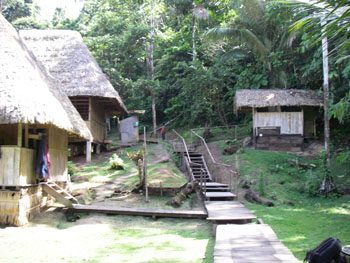 The NWC Reserve starts at the entrance to the Añangu stream mouth where there is a small settlement and staging post known as “The Warehouse”. Here we met our local guide, Jorge and switched to a much smaller dugout canoe to be paddled 12 km up the black water creek to the lodge. This part of the journey took a further two hours as we stopped from time to time along the way whenever birds and wildlife crossed our path. Sightings included Crowned Slaty-Flycatcher, White-eared Jacamar, Lesser Kiskadee, Bare-necked Fruit-Crow, White-chinned Jacamar, Rufescent Tiger-Heron, Hoatzin, Red-rumped Cacique, Long-billed Woodcreeper, Green Kingfisher, Snail Kite and Blue-and-Yellow Macaw. We also saw 2 Cayman Lizard, a troupe of White-fronted Capuchin and a Monk Saki monkey and baby, plus an Olive Whip Snake. We arrived at the lodge around 16.30 and had seen 40 species of birds today, taking our overall total to 545. The NWC Reserve starts at the entrance to the Añangu stream mouth where there is a small settlement and staging post known as “The Warehouse”. Here we met our local guide, Jorge and switched to a much smaller dugout canoe to be paddled 12 km up the black water creek to the lodge. This part of the journey took a further two hours as we stopped from time to time along the way whenever birds and wildlife crossed our path. Sightings included Crowned Slaty-Flycatcher, White-eared Jacamar, Lesser Kiskadee, Bare-necked Fruit-Crow, White-chinned Jacamar, Rufescent Tiger-Heron, Hoatzin, Red-rumped Cacique, Long-billed Woodcreeper, Green Kingfisher, Snail Kite and Blue-and-Yellow Macaw. We also saw 2 Cayman Lizard, a troupe of White-fronted Capuchin and a Monk Saki monkey and baby, plus an Olive Whip Snake. We arrived at the lodge around 16.30 and had seen 40 species of birds today, taking our overall total to 545.
Day 19: Wednesday 23rd January
After an early breakfast we were out on the lake at 06.45 for a short dugout canoe ride to a nearby creek and the start of the Tiputini trail. 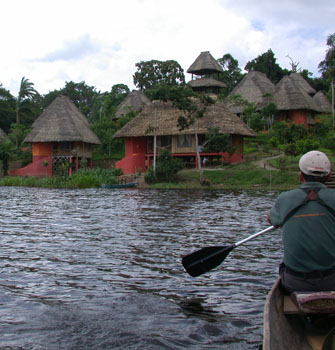 On the water we caught up with Ringed Kingfisher and Azure Gallinule briefly in flight, whilst back on dry land in the terra firme forest we saw Yellow-crowned Elaenia, a pair of Scale-breasted Woodpecker, Black-throated Trogon, White-flanked Antwren, Gilded Barbet, Spot-winged Antbird, Rufous-bellied Euphonia, Cinnamon-throated Woodcreeper, Black-tailed Trogon, Buff-throated Woodcreeper, Collared Puffbird, Bicoloured, Lunulated and Sooty Antbird, Black-faced Antthrush, 3 Yellow-billed Jacamar, Chestnut Woodpecker, Black-necked Red Cotinga and Blue-crowned Manakin. Amanda also saw Plain-winged Antshrike feeding amongst the antbird flock, but the bird eluded me. Amazon Dwarf Squirrel and an Elegant-eyed Lizard were the only other wildlife we encountered on our 7 km trek along the trail which became quite muddy and slippery at times. “Off road” excursions were necessary from time to time to catch some of the more secretive species and with thick undergrowth we were glad we were wearing wellingtons. Birding can be quite difficult at times with skulking antbirds etc and we were very grateful to Jorge for his sharp eyesight, excellent hearing and patience. We returned to the lodge at 11.45 for a 12.30 lunch and an afternoon siesta, before going out in a canoe once again at 16.00 to paddle up a nearby creek. As we were leaving the lagoon we spotted a Black Cayman resting by the bank but it moved off and submerged before I managed to get the camera out. We soon spotted 3 Red Howler Monkey and a small troupe of White-fronted Capuchin in the canopy overhead. Silvered Antbird put in a brief appearance at the foot of the bushes near the waters edge, whilst higher up in the canopy we saw 2 Black-fronted Nunbird, a roosting Great Potoo and a pair of Chestnut-fronted Macaw flew noisily overhead. We returned to the lagoon and slowly drifted around its perimeter, past a small colony of Long-nosed Bat, seemingly asleep on two poles rising out of the water. Nearby we spotted 3 Masked Crimson Tanager in small trees at the waterside and a pair of Speckled Chachalaca clambering from branch to branch as they moved around in the canopy. Having returned to the lodge we interrupted our early evening drinks just before dinner at 19.00 to find a Ferruginous Pygmy Owl we had heard calling near the cabins. Today yielded 62 species with 37 new birds taking our tally to 582. On the water we caught up with Ringed Kingfisher and Azure Gallinule briefly in flight, whilst back on dry land in the terra firme forest we saw Yellow-crowned Elaenia, a pair of Scale-breasted Woodpecker, Black-throated Trogon, White-flanked Antwren, Gilded Barbet, Spot-winged Antbird, Rufous-bellied Euphonia, Cinnamon-throated Woodcreeper, Black-tailed Trogon, Buff-throated Woodcreeper, Collared Puffbird, Bicoloured, Lunulated and Sooty Antbird, Black-faced Antthrush, 3 Yellow-billed Jacamar, Chestnut Woodpecker, Black-necked Red Cotinga and Blue-crowned Manakin. Amanda also saw Plain-winged Antshrike feeding amongst the antbird flock, but the bird eluded me. Amazon Dwarf Squirrel and an Elegant-eyed Lizard were the only other wildlife we encountered on our 7 km trek along the trail which became quite muddy and slippery at times. “Off road” excursions were necessary from time to time to catch some of the more secretive species and with thick undergrowth we were glad we were wearing wellingtons. Birding can be quite difficult at times with skulking antbirds etc and we were very grateful to Jorge for his sharp eyesight, excellent hearing and patience. We returned to the lodge at 11.45 for a 12.30 lunch and an afternoon siesta, before going out in a canoe once again at 16.00 to paddle up a nearby creek. As we were leaving the lagoon we spotted a Black Cayman resting by the bank but it moved off and submerged before I managed to get the camera out. We soon spotted 3 Red Howler Monkey and a small troupe of White-fronted Capuchin in the canopy overhead. Silvered Antbird put in a brief appearance at the foot of the bushes near the waters edge, whilst higher up in the canopy we saw 2 Black-fronted Nunbird, a roosting Great Potoo and a pair of Chestnut-fronted Macaw flew noisily overhead. We returned to the lagoon and slowly drifted around its perimeter, past a small colony of Long-nosed Bat, seemingly asleep on two poles rising out of the water. Nearby we spotted 3 Masked Crimson Tanager in small trees at the waterside and a pair of Speckled Chachalaca clambering from branch to branch as they moved around in the canopy. Having returned to the lodge we interrupted our early evening drinks just before dinner at 19.00 to find a Ferruginous Pygmy Owl we had heard calling near the cabins. Today yielded 62 species with 37 new birds taking our tally to 582.
Day 20: Thursday 24th January
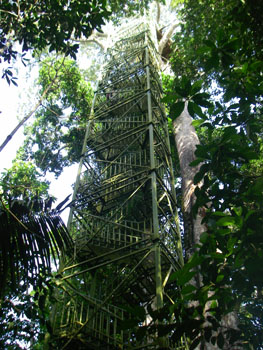 After an early breakfast we were heading across the lake at 05.40 for a 35 minute walk down the trail leading to the lodge’s canopy tower which is over 125 feet tall (207 steps) and stands adjacent to a giant Kapok tree where a platform has been constructed to enable guests to look out 360° over the top of the forest canopy. The aim is to be up the tower by first light when both bird and mammal activity is at its peak, before the day heats up. There are a number of fruiting trees in the area which attract numerous species only seen in the canopy thereby giving an opportunity to get much better views than usual from the forest floor. As we crossed the lake 6 Boat-billed Heron were returning to their lakeside roost from their day-time feeding grounds. On our walk to the tower we only stopped for a Great Tinamou and a Crested Forest Toad as we were “on a mission” to get up the tower pre-dawn. Having achieved our goal we were not disappointed by the birds, although some were quite distant, making a scope essential. We saw Buckley’s Forest Falcon sat for 20 minutes on top of a distant tree, Spangled Cotinga, 2 Eastern Sirystes, White-throated Toucan, Plum-throated Cotinga, White-necked Puffbird, Ivory-billed Aracari, Yellow-bellied Dacnis, Purple-throated Cotinga, Many-banded Aracari, Slate-colored Hawk and Casqued Oropendola amongst others we had seen previously, but in some cases, not so well. The tower platform is said to accommodate “over 15 guests with all their cameras, telescopes and equipment” – this is a little optimistic. Initially we thought we would be the only ones up the tower but as we were climbing to the top we heard the loud voices of another approaching group. With our two guides there were four of us plus one telescope; there were four “Brits” in the other party, plus Paul, an English speaking native guide from NWC and two other native guides, plus one telescope. After an early breakfast we were heading across the lake at 05.40 for a 35 minute walk down the trail leading to the lodge’s canopy tower which is over 125 feet tall (207 steps) and stands adjacent to a giant Kapok tree where a platform has been constructed to enable guests to look out 360° over the top of the forest canopy. The aim is to be up the tower by first light when both bird and mammal activity is at its peak, before the day heats up. There are a number of fruiting trees in the area which attract numerous species only seen in the canopy thereby giving an opportunity to get much better views than usual from the forest floor. As we crossed the lake 6 Boat-billed Heron were returning to their lakeside roost from their day-time feeding grounds. On our walk to the tower we only stopped for a Great Tinamou and a Crested Forest Toad as we were “on a mission” to get up the tower pre-dawn. Having achieved our goal we were not disappointed by the birds, although some were quite distant, making a scope essential. We saw Buckley’s Forest Falcon sat for 20 minutes on top of a distant tree, Spangled Cotinga, 2 Eastern Sirystes, White-throated Toucan, Plum-throated Cotinga, White-necked Puffbird, Ivory-billed Aracari, Yellow-bellied Dacnis, Purple-throated Cotinga, Many-banded Aracari, Slate-colored Hawk and Casqued Oropendola amongst others we had seen previously, but in some cases, not so well. The tower platform is said to accommodate “over 15 guests with all their cameras, telescopes and equipment” – this is a little optimistic. Initially we thought we would be the only ones up the tower but as we were climbing to the top we heard the loud voices of another approaching group. With our two guides there were four of us plus one telescope; there were four “Brits” in the other party, plus Paul, an English speaking native guide from NWC and two other native guides, plus one telescope.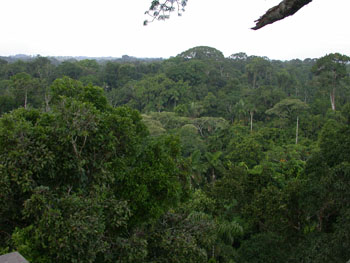 I can understand a guide’s desire to get all his party onto a species, but in such a confined space a certain amount of manners and decorum would not go amiss. Paul shuttled his party around all 4 sides of the platform, continually pushing in front of others and when I had the misfortune to be in the way of his scope, as Amanda and I were attempting to watch a bird he had only just spotted, I was summarily moved out of his way whilst at the same time a torrent of Spanish invective was addressed to Ruben our guide. Considering Paul’s linguistic ability it was a pity he didn’t have the courtesy or the courage to address me directly. In any event, Ruben said nothing to us and just moved away. With a clear sky, the day had soon heated up and with the warmth came swarms of small, annoying, biting insects. Despite copious amounts of insect repellent (we were in danger of toxic shock from all the Deet), the heat and the flies (not to mention a certain NWC guide) were just too much. We told Ruben we had had enough and went back down to the forest floor before 08.30. In any event, the bird activity in and above the canopy was slackening off quite markedly by then, so we moved on, further into the forest in search of a manakin lek. On the way we came across Rusty-belted Tapaculo and Black-faced Antbird skulking in the undergrowth. I can understand a guide’s desire to get all his party onto a species, but in such a confined space a certain amount of manners and decorum would not go amiss. Paul shuttled his party around all 4 sides of the platform, continually pushing in front of others and when I had the misfortune to be in the way of his scope, as Amanda and I were attempting to watch a bird he had only just spotted, I was summarily moved out of his way whilst at the same time a torrent of Spanish invective was addressed to Ruben our guide. Considering Paul’s linguistic ability it was a pity he didn’t have the courtesy or the courage to address me directly. In any event, Ruben said nothing to us and just moved away. With a clear sky, the day had soon heated up and with the warmth came swarms of small, annoying, biting insects. Despite copious amounts of insect repellent (we were in danger of toxic shock from all the Deet), the heat and the flies (not to mention a certain NWC guide) were just too much. We told Ruben we had had enough and went back down to the forest floor before 08.30. In any event, the bird activity in and above the canopy was slackening off quite markedly by then, so we moved on, further into the forest in search of a manakin lek. On the way we came across Rusty-belted Tapaculo and Black-faced Antbird skulking in the undergrowth. 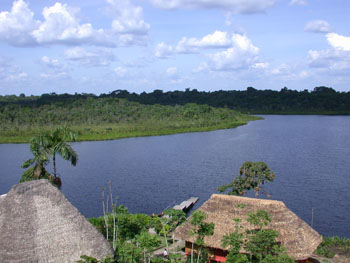 Hearing the call of a manakin in the distance we left our gear on the track and headed into the undergrowth to eventually locate 2 male Blue-backed Manakin, before turning around and retracing our steps along the tower trail. We could still hear a steam of chatter from up the tower, so at least, nothing had been disturbed along the trail on the way back. Ruben managed to coax a sleepy Black Tarantula from its daytime siesta in a hole in the forest floor and we were able to admire a beautiful Glass-winged Satyr butterfly which decided to rest on a log at the side of the trail. We also came across a very elusive Dwarf Tyrant-Manakin, calling in the trees above the trail. Luckily Jorge heard another bird calling a little further down the trail and as we moved on we had excellent views as the bird sat on a bare branch just above our heads. A little further on we saw an Amazon Forest Dragon lizard stretched lazily on a large tree branch on the forest floor. We were back at the lodge by 10.30 and went to our cabin to chill out. Sitting on our veranda I took the opportunity to catch up with photos of some of the more common species around the lodge including 2 inquisitive Black-capped Donacobius, a confiding Striated Heron, Smooth-billed Ani and a small party of Yellow-spotted Turtle enjoying the sunshine on logs at the water’s edge. Reflecting the mood, a Swallow-tailed Kite glided lazily over the trees on the opposite side of the lake disturbing the occasional Plumbeous Pigeon and an Amazon Kingfisher flashed by, before returning a few minutes later at a more leisurely pace to give much better views. Hearing the call of a manakin in the distance we left our gear on the track and headed into the undergrowth to eventually locate 2 male Blue-backed Manakin, before turning around and retracing our steps along the tower trail. We could still hear a steam of chatter from up the tower, so at least, nothing had been disturbed along the trail on the way back. Ruben managed to coax a sleepy Black Tarantula from its daytime siesta in a hole in the forest floor and we were able to admire a beautiful Glass-winged Satyr butterfly which decided to rest on a log at the side of the trail. We also came across a very elusive Dwarf Tyrant-Manakin, calling in the trees above the trail. Luckily Jorge heard another bird calling a little further down the trail and as we moved on we had excellent views as the bird sat on a bare branch just above our heads. A little further on we saw an Amazon Forest Dragon lizard stretched lazily on a large tree branch on the forest floor. We were back at the lodge by 10.30 and went to our cabin to chill out. Sitting on our veranda I took the opportunity to catch up with photos of some of the more common species around the lodge including 2 inquisitive Black-capped Donacobius, a confiding Striated Heron, Smooth-billed Ani and a small party of Yellow-spotted Turtle enjoying the sunshine on logs at the water’s edge. Reflecting the mood, a Swallow-tailed Kite glided lazily over the trees on the opposite side of the lake disturbing the occasional Plumbeous Pigeon and an Amazon Kingfisher flashed by, before returning a few minutes later at a more leisurely pace to give much better views. At 16.00 I went back out in a dugout canoe with Ruben and Jorge to explore the main creek, back towards The Warehouse, at a more leisurely pace. Amanda decided to stay cool and insect free back at the cabin and missed 2 Scarlet-crowned Barbet, Slender-billed Kite, Black Caracara, Blue-tailed Emerald, Lettered Aracari, American Pygmy Kingfisher and White-necked Puffbird. We spent quite a bit of time trying to locate calling Cinnamon Attila, without any luck and watched a Yellow-footed Tarantula on the waterside grass as we drifted by. As darkness descended we tried to locate our main target, Zigzag Heron which was calling repeatedly nearby. Despite Jorge’s best efforts, standing up in the canoe and shining his lamp on the vegetation and bushes at the side of the creek, we had no luck. By this time it had gone dark and numerous Bulldog Fishing Bat skimmed the water all around us, moving up and downstream, seemingly oblivious of our presence in the canoe. Returning to the lodge, the glassy eyes of a Pauraque and several Black Caiman glistened like stars at the waters edge in the light of Jorge’s lamp. As we neared the first cabin we heard an owl calling and we beached the canoe at the lakeside rather the return to the jetty. We were rewarded with excellent views of a Tropical Screech-Owl perched on a low branch at the edge of the forest. With 79 species for the day the overall total passed 600 and ended up at 611. We could probably have added more if we had persevered with the tower in the morning, but birding in such unpleasant conditions is not fun and no amount of new species can make up for such discomfort. The previous evening we had been advised we would be joined by two other people the next day, as Ruben was to be their guide for the following 3 days. As they were not birders, this was not ideal; but at the outset we had been advised we may become part of a larger party whilst at NWC if numbers dictated. At 16.00 I went back out in a dugout canoe with Ruben and Jorge to explore the main creek, back towards The Warehouse, at a more leisurely pace. Amanda decided to stay cool and insect free back at the cabin and missed 2 Scarlet-crowned Barbet, Slender-billed Kite, Black Caracara, Blue-tailed Emerald, Lettered Aracari, American Pygmy Kingfisher and White-necked Puffbird. We spent quite a bit of time trying to locate calling Cinnamon Attila, without any luck and watched a Yellow-footed Tarantula on the waterside grass as we drifted by. As darkness descended we tried to locate our main target, Zigzag Heron which was calling repeatedly nearby. Despite Jorge’s best efforts, standing up in the canoe and shining his lamp on the vegetation and bushes at the side of the creek, we had no luck. By this time it had gone dark and numerous Bulldog Fishing Bat skimmed the water all around us, moving up and downstream, seemingly oblivious of our presence in the canoe. Returning to the lodge, the glassy eyes of a Pauraque and several Black Caiman glistened like stars at the waters edge in the light of Jorge’s lamp. As we neared the first cabin we heard an owl calling and we beached the canoe at the lakeside rather the return to the jetty. We were rewarded with excellent views of a Tropical Screech-Owl perched on a low branch at the edge of the forest. With 79 species for the day the overall total passed 600 and ended up at 611. We could probably have added more if we had persevered with the tower in the morning, but birding in such unpleasant conditions is not fun and no amount of new species can make up for such discomfort. The previous evening we had been advised we would be joined by two other people the next day, as Ruben was to be their guide for the following 3 days. As they were not birders, this was not ideal; but at the outset we had been advised we may become part of a larger party whilst at NWC if numbers dictated.
Day 21: Friday 25th January
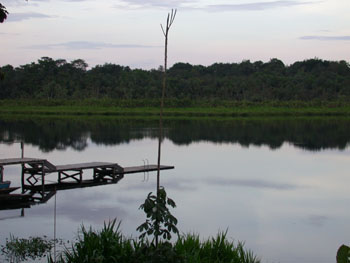 After another early breakfast I was on the lake again by 05.30 with Jorge, Ruben and his new clients Bruce and Pamela, a charming couple from Michigan, heading for the Napo River and NWC’s parrot clay licks, where sturdy and comfortable hides have been constructed along with primitive toilet facilities. Shortly after leaving the lake, we once again heard Zigzag Heron, but a short search proved fruitless. We had better luck further downstream with Rufous-breasted Hermit, Green-and-Rufous Kingfisher and Grey-necked Wood Rail, along with a small troupe of Golden Mantled Tamarind. Sunken tree trunks and branches frequently scraped the bottom of the canoe as the creek was noticeably much lower than when we arrived, since when there had been no rain. As we moved out into the main river the canoe grounded three times on sandbanks with Jorge and Ruben having to get out and pull/roll the canoe along until we reached the motorised canoe which was beached on a large sandbank at the start of the small channel into the creek. There were a few birds on the sand including a Lesser Yellowlegs, Spotted Sandpiper and Oriole Blackbird. We travelled down the river for a short distance to the largest of the parrot licks, the “Saladero de Loros” where we saw well over 200 Mealy and several Yellow-crowned Amazon, along with 50+ Blue-headed Parrot and slightly less Dusky-headed Parakeet. We returned the motorised canoe, set off back towards the creek and got out again at a small landing stage on the main river bank as the canoe could no longer navigate the creek. After another early breakfast I was on the lake again by 05.30 with Jorge, Ruben and his new clients Bruce and Pamela, a charming couple from Michigan, heading for the Napo River and NWC’s parrot clay licks, where sturdy and comfortable hides have been constructed along with primitive toilet facilities. Shortly after leaving the lake, we once again heard Zigzag Heron, but a short search proved fruitless. We had better luck further downstream with Rufous-breasted Hermit, Green-and-Rufous Kingfisher and Grey-necked Wood Rail, along with a small troupe of Golden Mantled Tamarind. Sunken tree trunks and branches frequently scraped the bottom of the canoe as the creek was noticeably much lower than when we arrived, since when there had been no rain. As we moved out into the main river the canoe grounded three times on sandbanks with Jorge and Ruben having to get out and pull/roll the canoe along until we reached the motorised canoe which was beached on a large sandbank at the start of the small channel into the creek. There were a few birds on the sand including a Lesser Yellowlegs, Spotted Sandpiper and Oriole Blackbird. We travelled down the river for a short distance to the largest of the parrot licks, the “Saladero de Loros” where we saw well over 200 Mealy and several Yellow-crowned Amazon, along with 50+ Blue-headed Parrot and slightly less Dusky-headed Parakeet. We returned the motorised canoe, set off back towards the creek and got out again at a small landing stage on the main river bank as the canoe could no longer navigate the creek.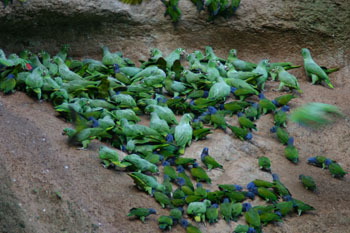 After a short walk we reached the “Saladero de Pericos” at around 09.00 where we saw several Orange-cheeked Parrot, small numbers of Scarlet-shouldered Parrotlet, c100 Cobalt winged Parakeet and a single Scarlet Macaw. The dry and sunny weather conditions were ideal for the clay licks and the parrot activity was fast and frenetic. After an hour and brief drink and snack, we set off back along a different trail to The Warehouse, bypassing the mouth of the creek. Jorge took me off the main trail to show me 2 Great-billed Hermit which are regular here and a little further on he pointed out a roosting Crested Owl, just under the canopy. Although we were able to get the bird in the scope, unfortunately most of its very distinctive face remained hidden by the foliage. Before reaching our destination at 10.40 we also picked up Grey Elaenia and I was left to admire a Velvet-fronted Grackle as the rest of the party went to visit the local shaman for a brief purifying ceremony. We set off back up the creek to the lodge in the dugout canoe at 11.00 and on the way managed to see a Tayra, a member of the weasel family, as it crossed over the creek in the canopy above us. After yesterday’s fruitless search we also saw a Cinnamon Attila calling out in the open for a short while and 2 Tropical Night Monkey peering out of their hole in a large tree trunk. We reached the lodge by 13.00 just in time for lunch. Originally we had been told the trip would take a whole day, with a picnic lunch and returning to the lodge by 16.00. After a short walk we reached the “Saladero de Pericos” at around 09.00 where we saw several Orange-cheeked Parrot, small numbers of Scarlet-shouldered Parrotlet, c100 Cobalt winged Parakeet and a single Scarlet Macaw. The dry and sunny weather conditions were ideal for the clay licks and the parrot activity was fast and frenetic. After an hour and brief drink and snack, we set off back along a different trail to The Warehouse, bypassing the mouth of the creek. Jorge took me off the main trail to show me 2 Great-billed Hermit which are regular here and a little further on he pointed out a roosting Crested Owl, just under the canopy. Although we were able to get the bird in the scope, unfortunately most of its very distinctive face remained hidden by the foliage. Before reaching our destination at 10.40 we also picked up Grey Elaenia and I was left to admire a Velvet-fronted Grackle as the rest of the party went to visit the local shaman for a brief purifying ceremony. We set off back up the creek to the lodge in the dugout canoe at 11.00 and on the way managed to see a Tayra, a member of the weasel family, as it crossed over the creek in the canopy above us. After yesterday’s fruitless search we also saw a Cinnamon Attila calling out in the open for a short while and 2 Tropical Night Monkey peering out of their hole in a large tree trunk. We reached the lodge by 13.00 just in time for lunch. Originally we had been told the trip would take a whole day, with a picnic lunch and returning to the lodge by 16.00.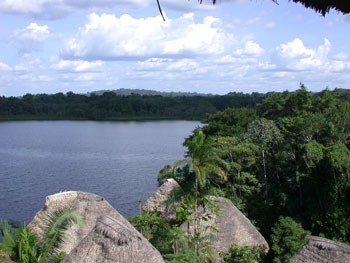 In view of the heat, we thankfully fought against such a long stretch outdoors; there is only so much pleasure to be gained from watching the same seven or eight species of parrot at a clay lick and anything longer than the hour we spent at each location would have been too much – even an hour was perhaps stretching it a bit! In the afternoon we were promised “an introduction to the birds of the area” from 16.30 onwards in the 19 metre (60 foot – 44 steps) observation tower which is accessed from the lodge dining room. As we were about to spend the last of 4 nights at NWC and had already visited the tower on several occasions, this was not our idea of a good time. Ruben arrived at 16.47 with no explanation or apology, wasn’t interested in confirming the ID of the only new species we saw, Grey-rumped Swift and spent the majority of his time talking to his other clients and a Canadian family who had joined us. Having enjoyed the exclusive services of a bird guide until this point we realised, rather too late, that the focus moves substantially away from birds once non-birders join a group. With hindsight, we would have no doubt seen a few more birds and stayed more focused on our own objectives if we had insisted on our own personal guide. We also saw 4 Golden-mantled Tamarind foraging close by and had good views of a White-throated Toucan before calling it a day and retiring to the bar at 18.30. Of today’s 60 species, 13 were new, to take our total to 624. In view of the heat, we thankfully fought against such a long stretch outdoors; there is only so much pleasure to be gained from watching the same seven or eight species of parrot at a clay lick and anything longer than the hour we spent at each location would have been too much – even an hour was perhaps stretching it a bit! In the afternoon we were promised “an introduction to the birds of the area” from 16.30 onwards in the 19 metre (60 foot – 44 steps) observation tower which is accessed from the lodge dining room. As we were about to spend the last of 4 nights at NWC and had already visited the tower on several occasions, this was not our idea of a good time. Ruben arrived at 16.47 with no explanation or apology, wasn’t interested in confirming the ID of the only new species we saw, Grey-rumped Swift and spent the majority of his time talking to his other clients and a Canadian family who had joined us. Having enjoyed the exclusive services of a bird guide until this point we realised, rather too late, that the focus moves substantially away from birds once non-birders join a group. With hindsight, we would have no doubt seen a few more birds and stayed more focused on our own objectives if we had insisted on our own personal guide. We also saw 4 Golden-mantled Tamarind foraging close by and had good views of a White-throated Toucan before calling it a day and retiring to the bar at 18.30. Of today’s 60 species, 13 were new, to take our total to 624.
One of the biggest disappointments at NWC was not seeing the resident family of Giant River Otters – they hadn’t been seen for a while when we were there. We managed to see 5 of the 11 species of monkey which make the area their home and many wonderful species of butterfly, including the magnificent Owl Butterfly Caligo memnon and the stunning Blue Morpho Morpho Menelaus.
Day 22: Saturday 26th January
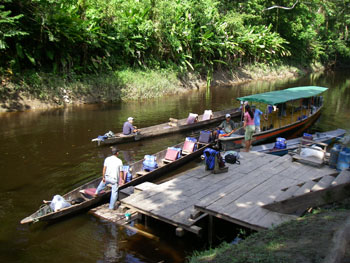 After our final early breakfast we left NWC behind at 06.30 for one last paddle through the flooded palm forest back out to the River Napo. We ended up in a dugout canoe with a couple we hadn’t previously met, who had been staying at the lodge, together with their native guide and two of his colleagues. Travelling downstream and with three paddles, we reached The Warehouse in a little over an hour. Thankfully there had been heavy rain in the mountains during the past couple of days and the level of the River Napo had risen sufficiently to allow the motorised launch to navigate the creek to the landing stage making our transfer much simpler. When all our bags had been stowed away we moved on at 08.00 and into the main channel to head upstream to Coca. We added a few more birds to our daily list on the way, including one new species, a lone Yellow-billed Tern which we overtook as it plied its way along the river. We reached Coca by 10.15 and transferred to the comfort of the air-conditioned airport for our 12.15 flight back to Quito. Once again, our baggage and booking in formalities were handled by the NWC staff and we went straight through to the lounge for a welcome coffee. The flight left 10 minutes early and with Sandra from Neblina Forest waiting for us at the other end, we were back at Hotel Sebastian by 13.00 just in time for lunch. After retrieving our cases we repacked then went for a walk around Quito and visited a nearby book store. Before dinner we went to the hotel lobby to fire-off some last minute emails and were both surprised and pleased to see William, who was just rounding off the daily bird list for a group he was guiding. After our final early breakfast we left NWC behind at 06.30 for one last paddle through the flooded palm forest back out to the River Napo. We ended up in a dugout canoe with a couple we hadn’t previously met, who had been staying at the lodge, together with their native guide and two of his colleagues. Travelling downstream and with three paddles, we reached The Warehouse in a little over an hour. Thankfully there had been heavy rain in the mountains during the past couple of days and the level of the River Napo had risen sufficiently to allow the motorised launch to navigate the creek to the landing stage making our transfer much simpler. When all our bags had been stowed away we moved on at 08.00 and into the main channel to head upstream to Coca. We added a few more birds to our daily list on the way, including one new species, a lone Yellow-billed Tern which we overtook as it plied its way along the river. We reached Coca by 10.15 and transferred to the comfort of the air-conditioned airport for our 12.15 flight back to Quito. Once again, our baggage and booking in formalities were handled by the NWC staff and we went straight through to the lounge for a welcome coffee. The flight left 10 minutes early and with Sandra from Neblina Forest waiting for us at the other end, we were back at Hotel Sebastian by 13.00 just in time for lunch. After retrieving our cases we repacked then went for a walk around Quito and visited a nearby book store. Before dinner we went to the hotel lobby to fire-off some last minute emails and were both surprised and pleased to see William, who was just rounding off the daily bird list for a group he was guiding.
Day 23: Sunday 27th January
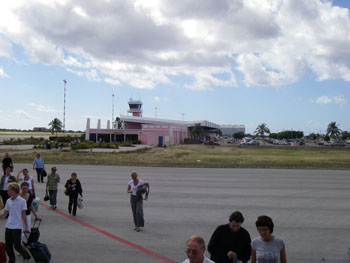 After a leisurely breakfast we were picked up from Hotel Sebastian at 07.30 to go to the airport for our flight home at 10.15. After a delay in Guayaquil the plane was 20 minutes late arriving in Quito and we eventually left at 10.45. Despite this delay and a further 45 minute wait at Bonaire where a passenger required medical assistance, we arrived 10 minutes early in Amsterdam the following morning. After a leisurely breakfast we were picked up from Hotel Sebastian at 07.30 to go to the airport for our flight home at 10.15. After a delay in Guayaquil the plane was 20 minutes late arriving in Quito and we eventually left at 10.45. Despite this delay and a further 45 minute wait at Bonaire where a passenger required medical assistance, we arrived 10 minutes early in Amsterdam the following morning.
Day 24: Monday 28th January
Arrived Amsterdam 04.50. Departed 07.30 ten minutes late and arrived in Manchester 07.30 twenty minutes early. Airline schedules seem to have plenty of leeway these days. Unfortunately one of our cases only managed to catch the noon flight from Amsterdam, but it arrived home safely just 7 hours after us.
Back to Index
SUMMARY
Our trip to Ecuador had a very comprehensive three-week agenda which saw us birding throughout many different habitats and altitudes, enabling us to see some amazing wildlife and incredible landscapes. We stayed at some excellent bird lodges and hotels with the comfort factor helping to offset the early mornings. However, on reflection, it would probably have been better to plan some personal time for ourselves along the way to enable us to catch our breath and relax a little more, as the schedule we set was a little hectic at times. The arrangements handled by Neblina Forest were excellent throughout, with the only real disappointment being our last two days at Napo Wildlife Centre. Photo opportunities were quite limited at times as a result of the skulking nature of some of the birds, light levels on the forest trails and the speed with which a lot of the species we encountered seem to move on. Despite failing to pick up 23 of the species we heard, we saw an incredible 625 birds overall and I ended up with an amazing 523 lifers. (Both totals include the "mystery" San Isidro Owl, but exclude two others: Clements classifies Stripe-billed Aracari and Pale-mandibled Aracari as sub-species of Collared Aracari Pteroglossus torquatus and Chestnut-mandibled Toucan as a sub-species of Black-mandibled Toucan.)
Some Useless Species Statistics
Total West Slope: 165 (plus 3 heard)
Seen only on West Slope: 65
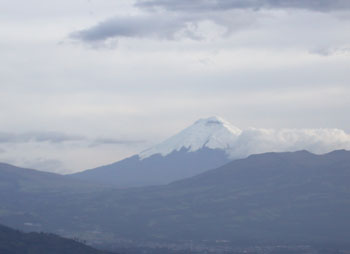 Total Loja and the SE: 157 (plus 3 heard) Total Loja and the SE: 157 (plus 3 heard)
Seen only Loja and the SE: 56
Total NW Choco region: 145 (plus 7 heard)
Seen only NW Choco region: 77
Total East Slope: 177 (plus 5 heard)
Seen only East Slope: 61
Total Quito and N Andes: 128 (plus 3 heard)
Seen only Quito and N Andes: 72
Total Amazon: 151 (plus 7 heard)
Seen only Amazon: 101
Regional endemics as defined by Ridgely: 65 (plus 6 heard)
Tanagers: 63
Hummingbirds: 65
Bird Photos 
Wildlife Photos
Ecuador Map
Napo Wildlife Centre Map
Ecuador Bird Checklist
Trip List
Trip Report Word Format or Adobe PDF
David and Amanda Mason
|
